Program
Meaningful Play 2018 includes thought-provoking presentations from leaders in academia and industry, peer-reviewed paper presentations, panel sessions (including academic and industry discussions), innovative workshops, roundtable discussions, and exhibitions of games.
Below is the detailed conference schedule. You can also view the abbreviated schedule.
Wednesday, October 10, 3:30p-5:00p
The Surprising Synergy of Medicine, Games, and VR | |
| Location | MSU Main Library, Green Room, Level 4 West |
| Format | Pre-Conference Event |
| Presenter(s) |
|
| Description | If you are looking for something to do Wednesday before Meaningful Play, MSU is hosting an AR/VR Symposium and Meaningful Play attendees are invited to the closing keynote, featuring Noah Falstein! NOTE: No additional registration is required to attend this event.
The event is within walking distance of the Marriott and MSU Union. It will likely take you 5-15 minutes to walk from the Marriott or MSU Union. At this event you can also get a jump on the conference by picking up your registration materials early. Arrive between 3:30-3:50 to grab your conference materials. Below is the description of the keynote: Game-related treatments have been cleared by the FDA for treatments of addiction, stroke recovery, and physical therapy. In early 2019, for the first time, a full-on video game may well be given de novo clearance by the FDA to be prescribed by doctors to treat children with ADHD, with current testing showing similar effectiveness to pharmaceuticals. This lecture will review other recent ventures using Virtual Reality to treat a variety of issues including phobias, PTSD, and acute and chronic pain. VR and games are also being used with great success to train caregivers and physicians. Also covered will be a wide range of business, technical, creative, and scientific challenges involved in creating and testing software of this type, and other opportunities for games as medicine that are opening in the near future. |
Wednesday, October 10, 5:00p-7:00p
Early Registration Check-In | |
| Location | East Lansing Marriott at University Place Lobby |
| Description | Get a jump on the conference by picking up your registration materials early in the lobby of the East Lansing Marriott at University Place. |
Thursday, October 11, 8:00a-9:00a
Registration Check-In and Continental Breakfast | |
| Location | Lobby (2nd floor of the MSU Union) |
| Description | The registration table is outside of the Ballroom on the second floor of the MSU Union building.
NOTE: The registration table will be open across the conference day. The breakfast is sponsored by the GameDev @ MSU. |
Thursday, October 11, 9:00a-9:30a
Conference Welcome | |
| Location | MSU Union Ballroom |
| Description | The conference organizing committee will welcome you and kick-off an exciting conference. |
Thursday, October 11, 9:30a-10:30a
Three Miles An Hour: Designing Games for the Speed of Thought | |
| Location | MSU Union Ballroom |
| Format | Keynote |
| Presenter(s) |
|
| Description | The much maligned concept of a "walking simulator" holds within it a clue to a kind of game design that we tend to ignore in our rush to design more and more choices into our systems of play. As writer Rebecca Solnit posits, "The rhythm of walking generates a kind of rhythm of thinking, and the passage through a landscape echoes or stimulates the passage through a series of thoughts." In this talk, Tracy considers the possibilities for uncommon mechanics such as walking, musing, waiting and reflecting for the design of games that go beyond "interesting" choices to offer deeply meaningful ones. |
Thursday, October 11, 10:30a-11:00a
Break
Thursday, October 11, 11:00a-12:00p
Physics is (still) You're Friend: The World of Goo @ 10 | |
| Location | MSU Union Ballroom |
| Format | Speaker |
| Presenter(s) |
|
| Description | In the spring of 2005, an experimental game was prototyped in seven days. This little experiment was Tower of Goo, and it was the seed that led to the development of the independent video game, World of Goo, which was released in the fall of 2008. The week before release, I gave the first "Well Played" talk at the first Meaningful Play. And shortly thereafter, I wrote a piece on the game that was published in 2009 as part of the book, Well Played 1.0. In the presentation and essay, I engaged in a close in-depth reading of World of Goo to help parse out the various meanings I found in my experience with the game. And now, ten years later, I want to take another look at the game and see how well the game holds up. |
Embodiment and Games | |
| Location | MSU Room |
| Format | Papers |
| Paper 1 | The Experience of Embodiment: Video Games Are Better With Stories Because narrative allows for robust player connection to game worlds and spaces, we argue in this paper that narrative is a vital aspect of game design, and the continued resurgence of the narrative debate underscores the need for feminist game studies. As Adrienne Shaw (2017) and others have proposed, the time is ripe for the inclusion of more intersectional feminist practices in game design and game scholarship, in order to better understand player positions in and around games. In this paper, we argue narrative is an essential component for that expansion and understanding. |
| Paper 2 | These Games Are Made for Walkin’: Walking Sims Step Up & Fill In The entertainment videogame market tends to be dominated by titles focused on action and competition. Although slower-paced narrative, puzzle, and mystery-based games have always held a place in the medium, the type of games pejoratively called walking simulators has recently become a heated topic of popular discussion--but little of this discussion has addressed the potential these games may hold for learning. In this paper, we analyze a sample of walking sims, drawing from popular and research literature as well as the public work of teachers using games in the classroom, to examine the common elements of walking sims and explore their educational potential. |
| Paper 3 | Teaching Literature Through Theatrical Play: Embodied Difference in Digital Theater Games This paper critically investigates the use of analog theater games to teach Shakespeare in K-12 and college classrooms, examining criticism that these games foreclose critical thinking, especially about gender and racial identity. The paper proposes that limitations of these games are a function of their analog format. As they are traditionally played, theater games treat the body as a tool and medium of expression, not as an object to be critically investigated. Digitally remediating these games addresses their shortcomings, as is shown through research on Play the Knave, a mixed reality motion capture Shakespeare game co-designed by the paper's author. Knave uses a motion sensing camera to capture player movement, mapping it onto an avatar. Since players act through an avatar, the game provokes players' awareness of the mediation of their bodies, organically opening up conversations about embodied difference and classroom diversity. |
| Paper 4 | Interoceptive Awareness: The "being" Dimension of "being There” in Games and Virtual Worlds In this paper we introduce, operationalize, and test a theoretical conceptualization of interoceptive awareness (IA) in games and virtual worlds that parallels neurobiological explanations of interoception and embodied presence. We developed a scale to measure state IA during a Virtual Reality (VR) experience by adapting the Multidimensional Interoceptive Awareness (MAIA) scale that was originally created to measure the effects of meditation programs on general propensity for interoceptive awareness in daily life (trait IA). Results suggest that: 1) state IA was correlated with and significantly higher than trait IA; 2) state IA during the meditation was not different between eyes closed and VR conditions, also VR display technology did not influence state IA; and 3) higher state IA was associated with significantly stronger feelings of spatial presence, whereas display technology had no relationship to spatial presence. |
Brushing History Against the Grain: Reclaiming Women's Stories Through Live-Action Role-Playing Games | |
| Location | Huron Room |
| Format | Workshop |
| Presenter(s) | Jessica Hammer and Moyra Turkington |
| Description | The War Birds project reclaims women's historical participation in war through live-action role-playing games. Each game asks the players to take on the roles of underrepresented or forgotten women, with the goal of broadening players' perspectives on history. In this workshop, participants will participate in structured design exercises to create live-action role-playing games that accomplish what Walter Benjamin called brushing history "against the grain." |
Teaching Game Development to Different Types of Students | |
| Location | Superior Room |
| Format | Panel |
| Presenter(s) | Jeremy Gibson Bond (moderator) |
| Description | Many of the concepts of game development are universal, but the ways in which we teach these concepts to students need to vary to adapt to the particular backgrounds and needs of the different students that we teach. Jeremy Gibson Bond leads a discussion of educators with expert knowledge in teaching different types of students, with each panelist giving a brief overview of their best practices for the types of students they teach followed by a group discussion with Q&A to answer your questions about how to approach various student groups. |
Design Thinking x Game Design | |
| Location | Lake Michigan |
| Format | Speaker |
| Presenter(s) | Mars Ashton |
| Description | Design Thinking is grounded in the world of Architecture, yet shares so many similarities to Game Development methods and practices. In this talk, we examine these similarities in an effort to better understand one of the most fundamentally important aspects of making a game: Design. Through a discussion of patterns, divergence, convergence, constraints, Iteration, Failure and more new perspectives will be found that will help shape a better understanding of pure Design and its application in Games. |
Indigenous Games | |
| Location | Lake Ontario |
| Format | Papers |
| Paper 1 | A Case Study of Dreamwalk – Leveraging Myth and Ritual for Game Design How can we design games that shed light on the human experience and can contribute to a meaningful life? This is a big question that seems to hold much interest for the gaming community. It is also an incredibly daunting one, screaming for definitions and qualifications: what is a meaningful life? To whom? How do we know a game is contributing to it?
|
| Paper 2 | He Au Hou: (Re)coding Hawaiian Survivance Through Gaming This paper is an exploration of the intersections of video game building, meaningful learning, and Hawaiian culture. It also takes up the challenges and rewards of organizing and running an inclusive trans-Indigenous workshops involving Indigenous and non-Indigenous participants and instructors from Turtle Island and Oceania. Further, this co-authored research investigates identity building, cultural development, programming and game creation from Hawaiian cultural and ontological perspectives, as well as the creation of connections to cultural heritage through developing a video game based in Hawaiian ways of knowing. |
| Paper 3 | Indigitalgames and the Representations of Indigenous Peoples Beyond Tomahawks and Headdresses As video games media continues to expand in popularity within pop-culture, game developers are continuously relying on Indigenous tropes and stereotypes to portray in their video games. Whether it be mystifying characters, objects or beings within games like Until Dawn, and Silent Hill or representing favorite Western-themed tropes seen within Mad Dog Macree 2, and Red Dead Redemption. These games surround Indigenous representations with sophisticated and often cynical associations that distort Indigenous cultures, traditions, and relationships. Using a blogging format for this analysis, the site indigitalgames.com archives representations of both positive and negative portrayals of Indigenous peoples to further expand on what symbols, characters, stories and environments video games use to portray Indigenous cultures and identity. The project has taken form as a blog format encouraging individuals interested in learning more about representations to follow the blog as more games will continuously be added to the site to continue the conversations surrounding representations into the future. |
| Paper 4 | Playing for the Future: A Picture Book App for Cultural Reclamation and Reconciliation This presentation emerges from a collaborative research project that is developing a series of picture book apps to support the grassroots cultural resurgence of the Rocky Cree people of northern Manitoba, Canada. Drawing on Anishinaabe digital game scholar Elizabeth LaPensée's claim that Indigenous games can serve as acts of survivance, "merging survival with endurance in a way that recognizes Indigenous peoples as thriving rather than merely surviving" (2017), the team seeks to decolonize technological tools and tropes and to explore the ways in which the gamification of education can support the goals of decolonization and reconciliation. The presentation recounts the challenges of developing game elements that honour the specificity of Rocky Cree worldviews and utilize what La Pensée calls culturally appropriate mechanics, including "slowing down, listening, making choices, revisiting paths, and interpreting the journey," focusing specifically on two games: Packing the Canoes and Gathering a Bundle. |
Thursday, October 11, 12:00p-1:30p
Birds of a Feather Lunch (on your own) | |
| Location | |
| Description | Thursday lunch is not provided. Take this time to socialize with your fellow conference attendees while enjoying the many dining venues within downtown East Lansing.
If you are interested in lunching with like minded individuals, there will be Birds of a Feather meet-up signs in the lobby. Meet at one of the signs and go to lunch together. The groups include:
|
Thursday, October 11, 1:30p-2:30p
Games Are Not Good for You | |
| Location | MSU Union Ballroom |
| Format | Keynote |
| Presenter(s) |
|
| Description | We live in what feel like particularly political times. Many of us working in games want to do something that will make a difference - that will impact larger cultural spheres in meaningful ways. However, are we really making the games that will get us there? In this critical (and self-critical) talk, Eric will look at some of the pitfalls of "serious games" and "meaningful play" - and offer new models for thinking about how games can interact with spaces outside of themselves. |
Thursday, October 11, 2:30p-3:00p
Break
Thursday, October 11, 3:00p-4:00p
Intra-InterDisciplinary Collaboration | |
| Location | MSU Union Ballroom |
| Format | Speaker |
| Presenter(s) |
|
| Description | By their multidisciplinary nature, games encourage their makers to learn new things—to be creative multi-classing autodidacts. It's helpful if a coder can write some music, a designer can sketch, or if an artist knows something about code. Jarryd and Hanna will talk about what they learned writing Game Programming for Artists—about collaboration, overcoming knowledge bias, learning together and how those same principles can apply across disciplines. |
Diversity in Games | |
| Location | MSU Room |
| Format | Papers |
| Paper 1 | How We Create and Embody the Other: Implications for Diversity in Character-Centric Games and Media (Top Paper Award) Any act of character creation is likely to entail stepping outside of the self. With regard to diversity and inclusivity in games and other character-centric media, the outcomes (e.g., whether certain media are sufficiently diverse, authentic, sensitive and inclusive) receive considerable attention from game designers and researchers; we think it is also critical to study and glean insights from the processes of character creation. In this paper, we present two complementary studies focused on understanding the role of diversity and identity in character creation. First, we present a qualitative interview study (N=14) with individuals who are deeply involved in character creation processes across various domains. Next, we present a survey study conducted with a more general population (N=101) recruited from Amazon Mechanical Turk (AMT), in which participants were instructed to conceive of and describe a fictional character before completing a parallel self-description task. From this pair of studies, we observed that the ways in which people relate to, understand, and struggle with their characters are deeply intertwined with understandings of the self. Moreover, in defining themselves and others, participants included but often transcended demographic traits, with non-demographic traits such as personality or ways of thinking about the world often holding greater weight. We discuss how our studies can enrich explorations of, and reflections on, diversity in games and play, and outline next steps we will pursue in this research. |
| Paper 2 | "She's Just Like Me!": How to Develop Character Designs Reflective of Diverse Children Twin Cities PBS is developing educational games for a new property, "Hero Elementary(w.t.)," supported by the U.S. Department of Education Ready to Learn grant. As the targeted audience for the games are located in low-income communities, we want to ensure that the character designs are relatable to these children. Numerous studies have indicated that racial minority group members are underrepresented in the media - regardless of the specific ethnic subgroup examined (i.e. Asian, African, American, Native American, African-American) (e.g. Klein & Shiffman, 2006). The present study describes the iterative and interdisciplinary methodology used to design and test diverse superhero characters (Black, biracial: Asian-American and White, Mexican-American and White) that represent diversity in various educational settings throughout the country. We summarize our findings from three iterative testing sessions and provide concrete recommendations for testing children with character designs. |
| Paper 3 | Racial Diversity in the Fighting Game Community In recent year competitive video games and game streaming has become an increasingly popular medium, along with competitive 'Esports' tournaments. Fighting games such as Street Fighter, Mortal Kombat, and Super Smash Brothers have their roots in early arcades and remain popular to this day. Video game communities are typically seen as being predominantly white, and when looking at game competitions outside of fighting games, this holds true (Paterson, 2017). While industry demographic reports gladly espouse the distribution of men and women playing video games, there is unfortunately a lack of racial demographics data however (Entertainment Software Association, 2017). Observational data suggest that fighting games seem to be different yet there is a lack of academic work examining this phenomenon. This study aims to answer if there is a heightened level of racial diversity within the fighting game community and explore what factors lead to it developing in this way. |
| Paper 4 | Abject Play My paper proposes a theory of abject play through an examination of gendered performances in The Binding of Isaac: Rebirth. In a number of previous analyses, Isaac's exemplification of abjection relates primarily--if not exclusively--to its representational aspects. To analyze and account for my own engagement with Isaac as a feminine experience, I suggest that abjection is not only a way to examine a game's representational or mechanical elements. Rather, it can be an approach to play--a subversive way of playing a game that may directly refute designer-intended meanings and oppose expected readings and audiences. Abject play occurs in the spaces between representation and mechanics, between game and player. By playing Isaac abjectly, I threaten and tear apart incoherent patriarchal narratives of feminine bodily order and regulation, even as I recognize and enact them by playing within the game's representational and rule structures. |
Cards Against Pedagogy: Using "Off-The-Shelf" Games In Your Teaching | |
| Location | Huron Room |
| Format | Workshop |
| Presenter(s) | Valerie Waldron, Johnathon Beals, Phill Cameron and Brenda Imber |
| Description | This workshop, designed primarily for instructors and instructional designers, is intended to help attendees evaluate how well, and in what ways, off the shelf games may fit into their teaching.
Presenters will discuss their experiences using a modified version of a commercial board game in a language classroom. We will explore:
This session is divided into three sections. Attendees will first play a shortened version of our modified game. Then they will share their reactions and reflections. Finally, participants will evaluate several hypothetical case studies intended to provoke thought about using games creatively in the classroom. Attendees are encouraged to bring in their own scenarios for further discussion. |
Serious Play on Twitch: Experiments in Academic Streaming | |
| Location | Superior Room |
| Format | Panel |
| Presenter(s) | Krista-Lee Malone, Nathan Humpal, Laya Liebeseller, Thomas Malaby, Kristopher Purzycki and Josh Rivers |
| Description | As a performative act, live-streaming gameplay provides the player with a direct channel into communities of practice wherein the inherent social qualities of play are foregrounded. Twitch has become a compelling platform for players looking to share their experiences while also attracting other live-streamers who share day-to-day activities, how-to demonstrations, and live avante-garde works.
Using the Serious Play channel, founded at UW - Milwaukee in 2017, this panel will discuss several considerations that have arisen during its ongoing run. The channel was made as an experiment in both streaming generally and in engaging the public with the academy. We do this through sharing scholarship and research during play, discussing play experiences (stories coming from both us and the audience) and by highlighting a range of games. This panel will discuss: Programming and Hardware, Streaming Tabletop Games, Contributing to the Academy, Pedagogical Uses, Critical Media, and Twitch As A Queer Platform. |
An Innovative Approach to Collaborative Game Design | |
| Location | Lake Michigan |
| Format | Speaker |
| Presenter(s) | Carrie Cole and Sarah Buchan |
| Description | A common issue teams encounter when designing educational games is finding a balance of learning and fun. In the absence of fun, players do not engage. In the absence of learning, the product fails to deliver on its intended outcome. To solve this, Age of Learning has built tension into the design process by pairing curriculum experts with game designers to build engaging and effective games. In this presentation, a Curriculum Specialist and a Game Designer from Age of Learning will dissect several live Mastering Math games to provide insight into how this collaboration works in the industry. |
Empathy and Gaming | |
| Location | Lake Ontario |
| Format | Papers |
| Paper 1 | Games of Fellowship: Affection, Empathy and Making Friendship Games While it might be stated that, "many games can foster friendship," with players learning or working together or players using games to spend time with family members the focus has not been explicitly on games designed for creating or fostering new or old friendships. Fellowship of Fools is a game designed to help guide players through developing a friendship with someone new, or deepening an existing relationship. The game prompts players for situations to role play together in which they must choose what are the best topics to explore in that given situation. Some topics may be too personal to ask too early in getting to know someone, or not appropriate for the situation at hand. In the game, players will navigate these possibilities and share feedback on how we choose to play and respond. The more time players spend in the game building experience, the deeper those relationships become.
|
| Paper 2 | (Re)Thinking Empathy Games Games and simulations have long been portrayed as a means of fostering understanding and empathy. However, empathy games have recently and deservedly been criticized as facile attempts to reproduce fundamentally inimitable experiences. As a result empathy games have increasingly been viewed with skepticism at best and derision at their worst. This talk rethinks empathy games from the perspective of feminist epistemology, phenomenology, psychology, disability studies, & rhetorical theory. In aligning empathy with these fields, the shortcomings of empathy games will be made clear and a path forward for designing more effective tools for fostering empathy will be laid out. |
| Paper 3 | Game Design Therapoetics: Authoring the Computer Game Autopathography In this paper, I discuss my arts-informed qualitative study and doctoral thesis on the self-healing resources of autopathographical game authorship. I mobilized the autopathography (the autobiographical illness and disability narrative) from literary theory, and organized an ethics-approved game jam in order to study the authorship processes of 13 professional game designers/developers. Their experiences with bipolar disorder, anxiety, ADHD, color blindness, PTSD, shyness, grief, and insomnia would inform their design. My findings show that autopathographical game design during a game jam may be healing through its four therapeutic dimensions: autopoiesis (re-making the self through introspection), fabulopoiesis (re-imagining the self through the game narrative), logopoiesis (re-perceiving the self through implementation), and sociopoiesis (shared storytelling during a game jam). I offer insights into how gamemakers are pushing the frontiers of artistic experimentation in games while forging a novel creative method of self-care--game authorship as an expressive form of design therapy. |
Thursday, October 11, 4:00p-4:30p
Break
Thursday, October 11, 4:30p-5:30p
Nuance in the Woods: Exploring Meaning in Games | |
| Location | MSU Union Ballroom |
| Format | Keynote |
| Presenter(s) |
|
| Description | Indie game Night in the Woods (NITW) examines themes of mental health and political issues through the medium of cute animal characters. Co-creator Alec Holowka reflects on the creation of NITW and explores some of the ways that video games can convey meaning. |
Thursday, October 11, 5:30p-7:00p
Dinner Break (on your own) | |
| Location | |
| Description | Dinner is not provided. Take this time to socialize with your fellow conference attendees while enjoying the many dining venues within the East Lansing and Lansing area. |
Thursday, October 11, 7:00p-10:00p
Conference Reception, Game Exhibition, and Poster Session | |
| Location | MSU Union Ballroom |
| Format | Reception |
| Description | Celebrate the end of the first successful day at Meaningful Play during the conference reception, featuring:
The conference reception is sponsored by Inclusive Game Dev Initiative. |
Poster Presentations | |
| Poster 1 | Educational Game Production Using the USC Game Production Method Even in AAA environments there is a constant commentary about how difficult it is to produce and ship games. Projects can face a variety of pitfalls such as bad concepts, bad gameplay, bad time estimates, and lack of funding all of which can ruin or severely impact a project. This leads to detrimental practices like crunch for the sake of shipping a product on time that most likely will have bugs on release. As a result, there is a striking amount of projects which have been abandoned or do not see wide release.
|
| Poster 2 | Friendship & Cooperative Play While much of video game research centers around whether violent video games produce aggressive behavior, there is a growing body of research suggesting that video games can produce pro-social outcomes as well. Given the growing popularity of couch co-op and competitive games such as Super Smash Brawl and Halo, further investigation into how cooperative vs competitive game play impacts relationships may be warranted, yet there is limited literature on how video game play impacts existing friendships and relationships.
|
| Poster 3 | ABCmouse Mastering Math: Using Gameplay to Estimate Learning Outcomes For educational games to be most effective, they should provide reliable measures of learning. This study evaluates how gameplay in ABCmouse Mastering Math - an adaptive educational game for early number sense skill development in preschool and kindergarten students - can estimate learning outcomes on a well-validated external assessment, Test of Early Mathematics Ability, 3rd edition (TEMA-3). To track how estimates of learning outcomes from Mastering Math change over time and how much gameplay is necessary for 'good enough' estimates, we built predictive models to estimate the predicted posttest TEMA-3 score from MM using in-game user telemetry. Results showed strong correlations between the predicted posttest score from Mastering Math and the observed TEMA-3 posttest score in several cross-validated models (R^2 ranged 0.47 - 0.59), suggesting that Mastering Math can provide reliable measures of student progress on specific number sense skills in the classroom. |
| Poster 4 | Cognitive Play: Exploring Differences in Sensemaking in Video Games What are students learning from 10,000 hours of video games? In this study, we explored sensemaking in video games and gamers. Sensemaking is defined as how people make sense of ideas, develop theories, and make connections between ideas. It is important in a variety of educational fields, including STEM, because it is part of problem solving and critical thinking. Our approach was two-fold. First, we examined the types of meaningful sensemaking that happens in popular games across several genres. Then, we examined correlations between game preferences and scales that measure different components of sensemaking. Participants (N=286) scores on sensemaking scales were not correlated with FPS, fighting, or racing games, but were positively correlated with role playing and puzzle game preferences. This work begins to examine the potential for informal learning about sensemaking from video games. |
| Poster 5 | Constructing Personas: MMO Games As Training Tools for Engaging in Digital-world Interaction The playing of a digital game, even a single player one, is in many ways a social act: An individual is responsible for constructing or embodying an in-game identity and must interact with other players to complete some sort of purposeful action. This project looks at how a Massively Multiplayer Online game teaches an individual how to construct a social identity, and how the act of character creation and in-game interactions serve as an introduction to this type of symbolic thinking.
|
| Poster 6 | Cross-Indexing Game Characteristics to Test Media Literacy Game Design Two college librarians are investigating which game elements and gameplay characteristics are most effective for student engagement, knowledge transfer, and skill development in media literacy instruction. Reporting on the exploratory phase of research, this poster demonstrates a novel method for cross-indexing existing and potential games according to game type (Grace, 2005), the kinds of learning experiences that happen during gameplay (Gee, 2003; Abdul Jabbar & Felicia, 2015), means of play (such as game board, cards, dice, digital platform, etc.), and specific media literacy objectives. This is a unique exercise, building on previous research in both game-based learning and media literacy education. Cross-indexing will help determine the game elements and gameplay characteristics to be tested in later phases of research. This poster presents the categorization schema developed, details findings of some of the most interesting juxtapositions among these elements, and provides illustrations representing games that are exemplary of these complex relationships. |
| Poster 7 | Giving You Your Space: Examining Game Space Expandability Video games are constantly changing to adapt to both technology and gamers. To best approach this media, it is, therefore, necessary to regularly re-evaluate the space in which gameplay occurs: game space. Game space is traditionally designated as the virtual space housing gameplay. The endeavor of this project is to propose an expansion to game space that best reflects how individuals are playing games and not merely as games are designed. The primary area of inclusion is non-player, or onlookers. Despite not personally playing the game, onlookers are able to take on roles similar to that of non-player characters within the game. Onlookers can provide insight or directions to the players. It is at that point that it is necessary to distinguish whether or not they are components of game space. From there, it is important to understand what this expansion means for game designers, developers, scholars, and players. |
| Poster 8 | How Real is Good? Cognitive Demand of Simulation Games and Self-efficacy Simulation games have been broadly found to be effective in enhancing learning. A simulation game is a simplification of reality. But how simple/real is good? The simpler the better or the real the better? |
| Poster 9 | Increasing Self-Advocacy of Adolescents Who Stutter Through Interactive Narrative Design While many persuasive games allow players to role-play to better understand an individual's or group's point of view, no known studies have evaluated the ability of patients to tell the story of their own disease/disorder through game design. Speech and language disorders, such as stuttering, often negatively affect an individual's quality of life. One approach to help patients with this issue is narrative therapy. The goal of narrative therapy is to change the patient's personal narrative from disorder-centric to patient-empowered, and Twine (twinery.org) can allow the creator (the patient) to design an interactive experience for readers, which may provide a novel way to increase patients' self-advocacy. We explore this idea through a study of individuals attending a summer camp for adolescents who stutter. We discuss the results of a group interview with summer camp attendees after all campers design their own interactive narratives. |
| Poster 10 | Learning Latin Through Gameplay: A Preview of an Educational Game in Development While Latin courses at the undergraduate level traditionally focus on translating texts written by elite Roman men, students could greatly benefit from an educational approach that makes the classical world more accessible to modern audiences by treating Latin more like a living language and emphasizing the lived experiences of ancient people,
|
| Poster 11 | Play Fulfillment in Adults: An Overview and Short Measure for Future Research The need for play - and the consequences of not getting enough play - has been studied for some time in animals and human children, but much less research has focused on the importance of play for adults. In this paper, we review what literature exists on an adult's need for play, and the implications of fulfilling or not fulfilling that need. We then describe the development of a new, brief self-report measure of adult play fulfillment that play scholars can use in future research. |
| Poster 12 | Seemingly Meaningless Games for Meaningful Learning: The Case for Seductive Media in Education This poster presents the foundation for a conceptual framework to teach 'seductive' media. The use of the term 'seductive' is a gesture towards Baudrillard's concept of seduction - which is in opposition to contemporary society's obsession with production - such as the relentless production of information and meaning in media (Baudrillard, 1987). Media and communication theories will be discussed alongside contemporary scholarship in education that cautions against the current push towards outcome-based education. Indeed, critiques of outcome-based education mirror comments of media and communication as totalitarian and absolute (Biesta, 2013). The theoretical position proposed here is to build upon contemporary critical media discourse that defines the attainment of media literacy in students being simply 'active producers' of media images and messages (Mediasmarts; European Commission). The position outlined in this paper seeks to promote in students an appreciation of, and perhaps even assist them in becoming future creators of, 'seductive' media. |
| Poster 13 | Student-Designed Learning Mini-Games in Higher Education for Use in the Classroom: Creating an Educational Video Game About Pharmacology with Game Design and Nursing, A Case Study The last decade has seen significant growth in game design degree programs. Considering the number of students practicing game design in higher education, their proximity to experts in a variety of fields, and the pedagogical potential of games, should institutions support the creation of student-developed educational mini-games for use in their curricula? Can students who are actively engaged in learning the skills of game design create effective learning experiences about subjects they aren't familiar with? Can these games be used within an institution to enhance learning outcomes and support overloaded, content-heavy curricula? This case study begins to explore answers to these questions within a specific context: a collaboration between undergraduate game design and nursing school programs at Quinnipiac University. The goal of the collaboration was to create an educational game about the basic concepts of pharmacology that could be used within the classroom at Quinnipiac as a tool for learning. This case study includes a review of the collaboration's structure, an examination of the development process, a description of the final game, and a study of its effectiveness as a learning tool. Promising post-test results from an initial study of 111 undergraduate nursing students point to the potential of using student-developed games in the classroom and support our approach. |
| Poster 14 | Toward Embodied Learning Mechanics: A Tool to Guide the Design of Physical Interactions in Educational Games Embodiment--the notion that cognition arises from both the mind and our bodies' physical/social interactions with the world--has become an important concept for designing physical interactions that enhance the efficacy of educational games. However, embodiment is a remarkably fuzzy term, with definitions that differ drastically depending upon the academic domain they originate from. As a result, there is limited existing work that aids in deciding which forms of embodiment and physical interactions might be most effective for learning specific concepts. In order to provide initial steps towards addressing this issue, I discuss different theoretical perspectives of embodiment, highlight how these diverse interpretations can greatly impact end design of educational games, and present the concept of embodied learning mechanics--i.e., the patterns of physical interactions that form the essential learning mechanics and activities repeated throughout a game--to guide the design of physical interactions in educational games. |
| Poster 15 | Wait Until Tomorrow: Exploring the Size of Delay on the Effectiveness of Crossword Games for Learning Scientific Vocabulary Word games are used extensively in STEM classrooms to help familiarize students with technical vocabulary and terminology. Despite their widely-documented use, only a handful have tested whether they are effective at improving either retention or use of scientific concepts, and the results of these studies has been mixed. We report the combined results of several studies in which university introductory psychology students studied course-relevant material in a study-delay-test design, to examine the effectiveness of word-game training for STEM vocabulary. Results showed that word games improved memory for the material, for both immediate and delayed tests, and retention was most enhanced in comparison to control when the clues were solved repeatedly and given with difficult orthographic hints. Results suggest that word games can be effective in this domain, but it depends on how they are implemented, and several factors including difficulty, repetition, and time delay are important predictors of retention. |
Exhibited Digital Games | |
| Game 1 | A Beautiful Story  A Beautiful Story is a single player 2D game on the experience of domestic violence, informed by a survivor. It eases players into this difficult topic by moving the setting from real life to that of penguins.
|
| Game 2 | A Day Half-Done (student-created game) 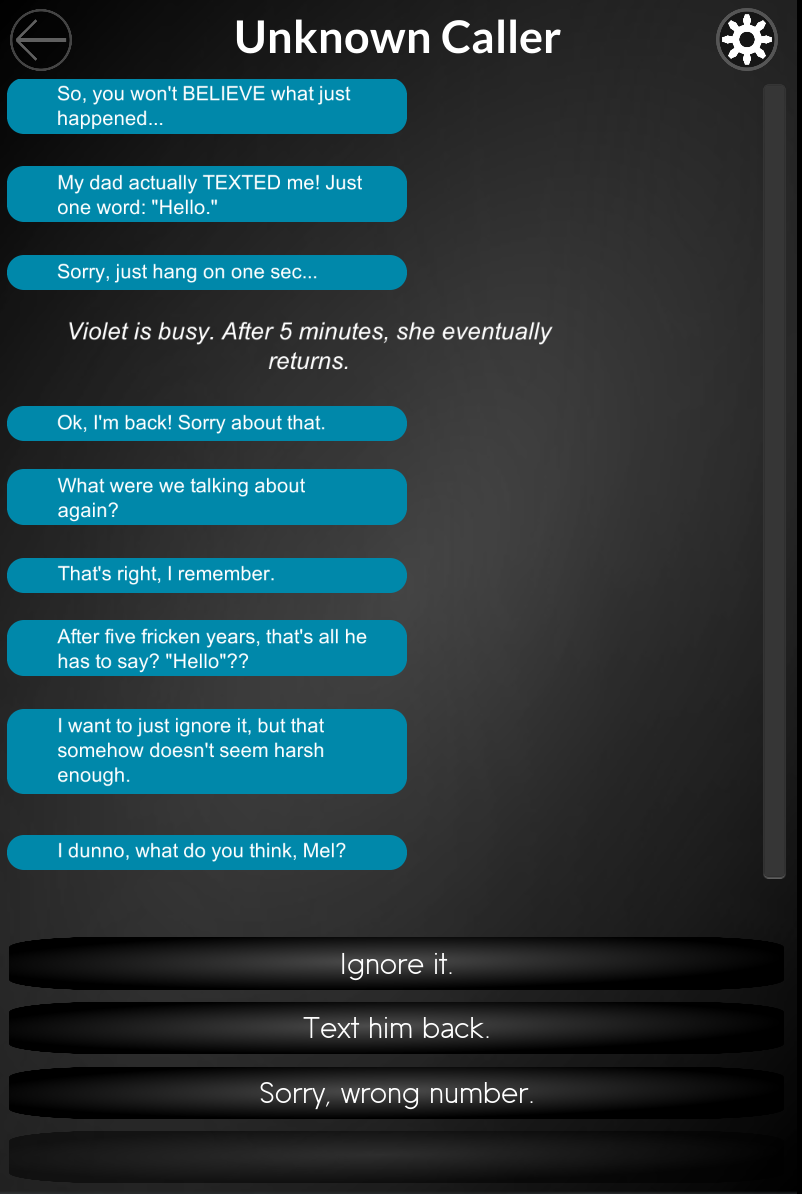 "A Day Half-Done" enables an ongoing dialogue with Violet, a college-aged woman who has Attention Deficit/Hyperactivity Disorder (ADHD). Like the "Lifeline" games, this dialogue is set up to resemble a text conversation and incorporates both short waits to indicate natural pauses in conversation, as well as longer breaks to indicate Violet is busy. As the player speaks to Violet, they not only learn more about her, but are also increasingly exposed to representations of her ADHD and the impact it has on her life.
|
| Game 3 | ABCmouse Mastering Math 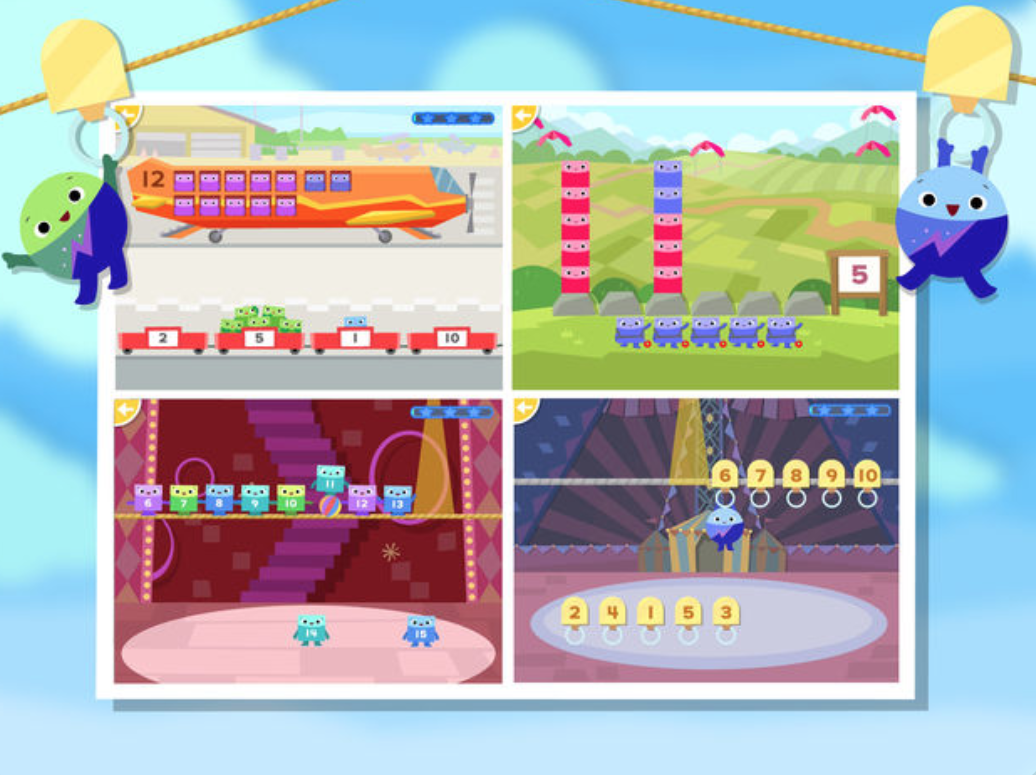 Mastering Math is a set of learning games that personalize to players. This adaptive game-based app helps preschool, prekindergarten, and early kindergarten children build a strong understanding of the most fundamental math concepts: the numbers one to one hundred and the quantities for which they stand.
|
| Game 4 | Allergory (student-created game) 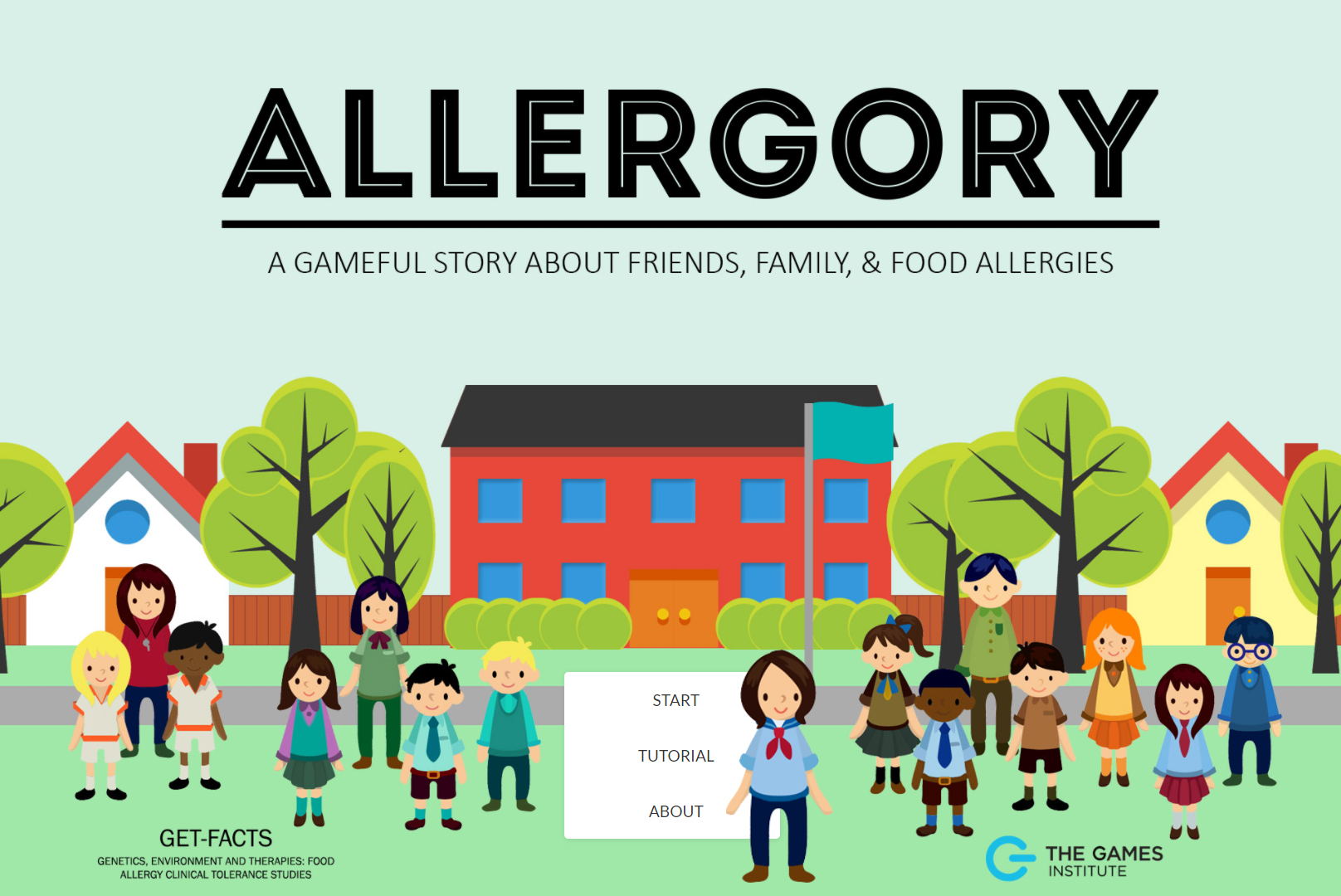 Children with food allergies experience higher levels of stress, anxiety, and bullying than non-food-allergic children. Allergory addresses this issue through the gameful story of Mia, a young girl who is allergic to peanuts. Players work with Mia as she transfers to a new school where she is the first food-allergic student. The game is intended to help non-food-allergic persons understand the social, cultural, and practical reality of having a food allergy. This is accomplished by training the player's imagination to discover knowledge that is situated in unfamiliar social and cultural situations. As a game design philosophy it draws inspiration from feminist epistemology, situated learning theory, and disability scholarship.
|
| Game 5 | Blood Myth (student-created game) 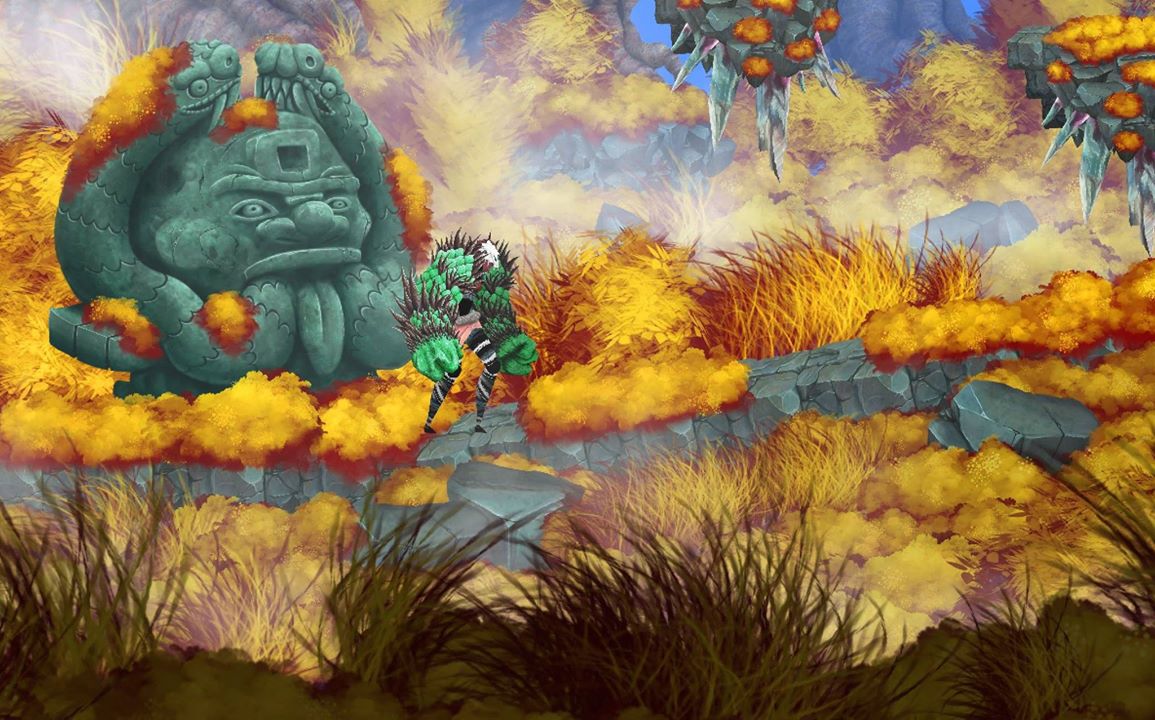 Blood Myth - Educating about Sickle Cell Disease through Gaming
|
| Game 6 | Brukel 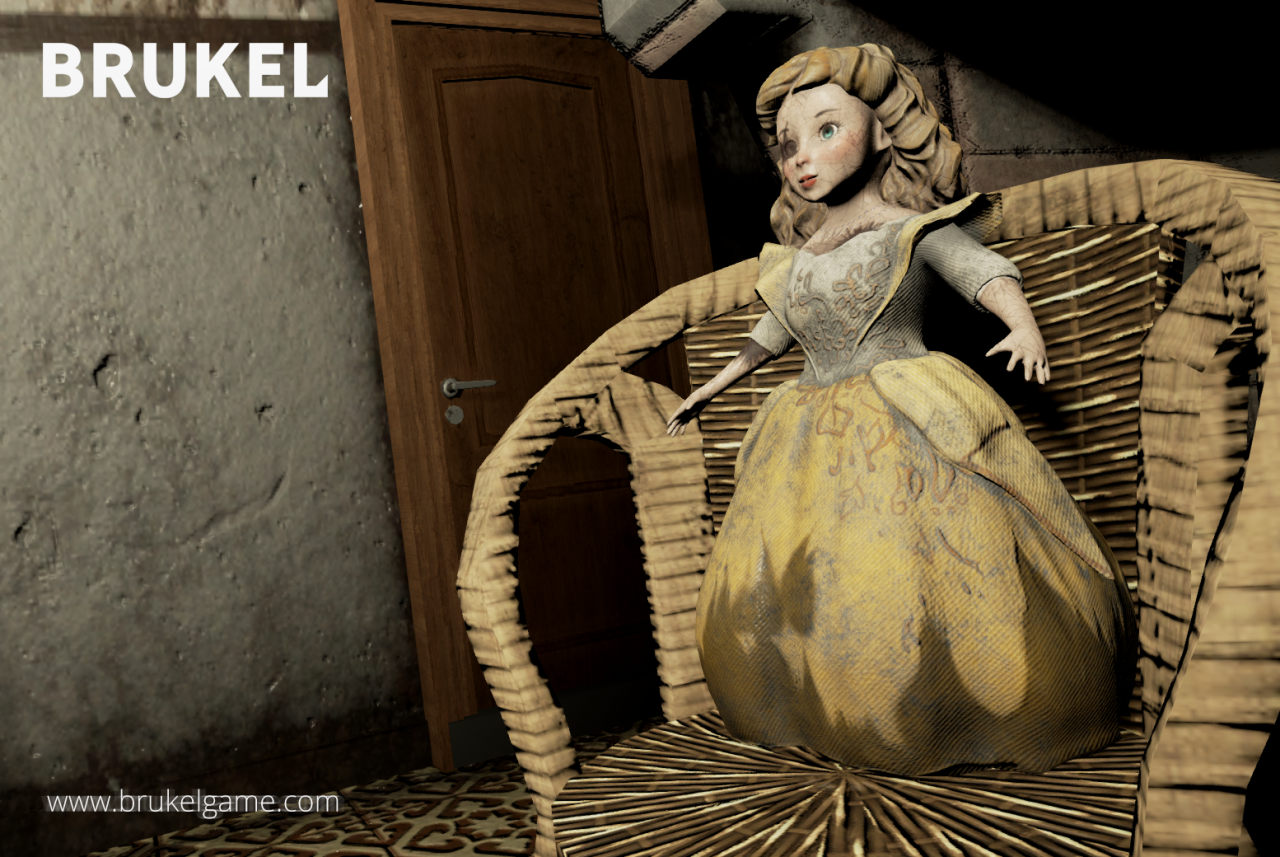 Brukel is an educational horror game that explores the childhood and teenage years of Bie Verlinden, who was born at the Brukel farmhouse in 1925. Bie was recorded reminiscing about her past at the farmhouse and her stories provided the foundation for the game. The unique design process of Brukel - in which the audio predates everything else - allowed for a game in which every audio fragment is not only authentic, but also spoken in the voice of the person who lived through them. Brukel aims to sensitize players about the reality of war and the impact that it has on the daily lives of people living on the battlefields, and it demonstrates how the history of a loved family member can be recreated in interactive fashion. |
| Game 7 | Cloudwalker (student-created game)  Cloudwalker is a platforming game centered around the legendary monkey king, Sun Wukong, as he seeks to reclaim his strength after a fateful battle. Using his cloud-walking boots, players take to the skies on your Jindou Cloud to dash across the environment, explore the wondrous heavens, and unravel the mystery behind a demon that embodies desire. |
| Game 8 | discomfort zone (student-created game)  discomfort zone is a 2D pixel-art narrative game about depression, anxiety disorder, despair, and recovery. The game takes a realistic, un-filtered, and at times uncomfortably personal look at depression and anxiety disorder through the eyes of someone dealing with these conditions, promoting understanding and sharing the experience with a wider audience. The game deals with many themes related to depression and anxiety: worry, loneliness, and self-deprecating thoughts, but also hope and finding the strength, when all seems lost, to keep going. Made in a heavily-hacked version of the Bitsy engine, the game uses a simple art style, limited color palette, and basic controls to ensure accessibility. |
| Game 9 | Dream Racer 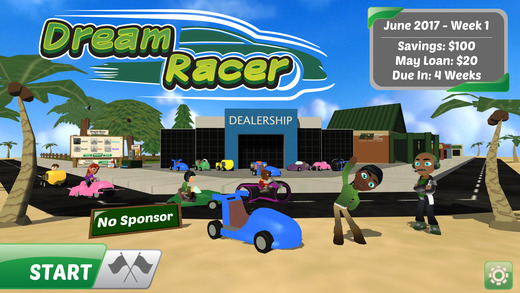 The roar of the engine, the thrill of the chase, you can smell first place but it is just out of reach! If only you weren't driving such a junker... You'll need to manage your finances as you hit the racing circuit, gain sponsorships, sell old racers, and pick out parts and upgrades to build your very own "dream racer". So start your engines and burn some rubber. Dream Racer is go-kart racing at its finest!
|
| Game 10 | Dwell 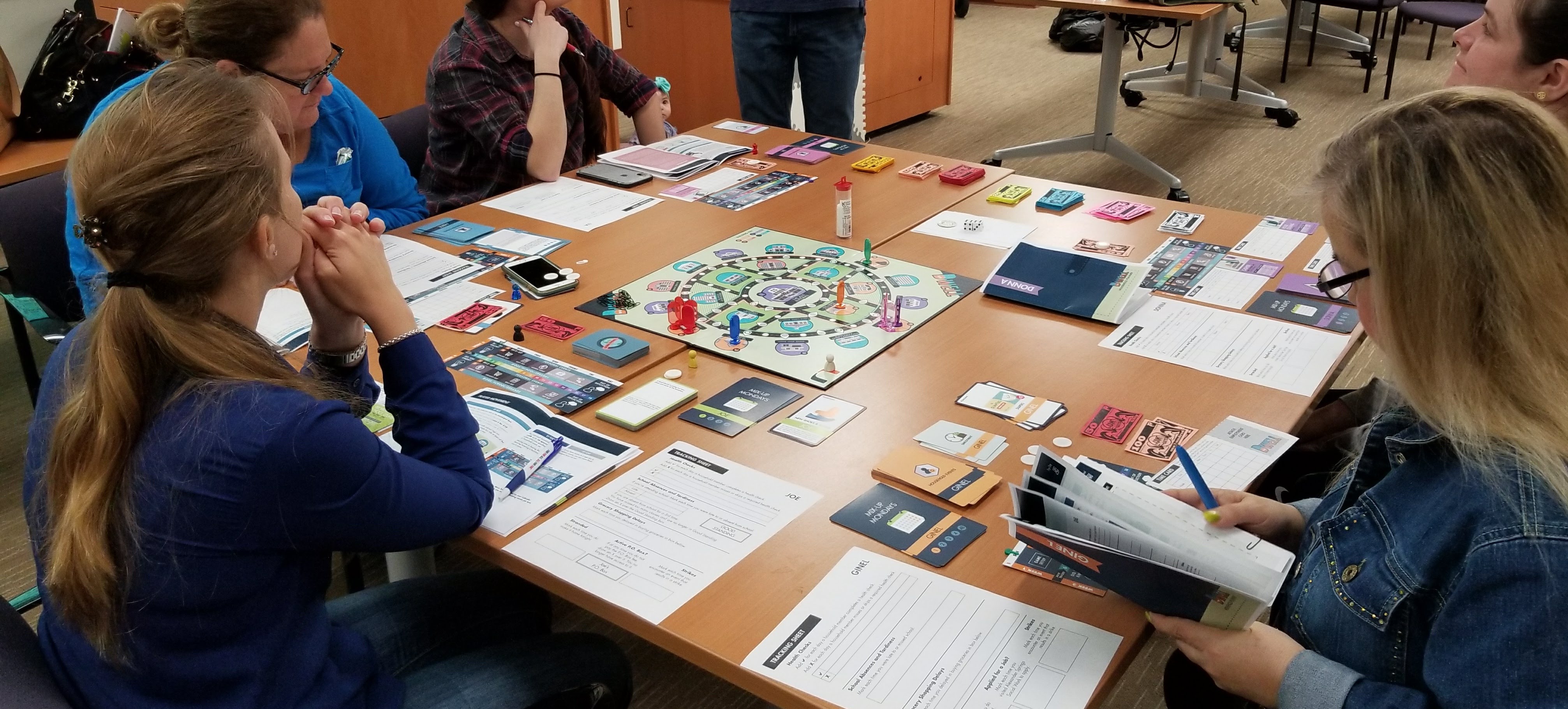 An interdisciplinary team of faculty from University of Miami's School of Communication and School of Nursing and Health Studies designed Dwell, a tabletop simulation game informing players through role-play about poverty's effect on one's ability to thrive. Research has shown that poverty influences the five dimensions of family, including health, productivity, physical environment, emotional well-being, and family interaction (Park, Turnbull, & Turnbull). Given the importance of educating future health care providers about these implications of poverty, the team brought together its experience in simulation, game design, and poverty and nursing education to iteratively design a facilitated simulation game with the goal of providing health care students an interactive role-playing experience that deepens their sensitivity towards future patients living below the poverty line by playing 1 of 5 households in the simulated town of Dwellville and participating in periodic in-game and post-game debrief.
|
| Game 11 | Forgotton Anne 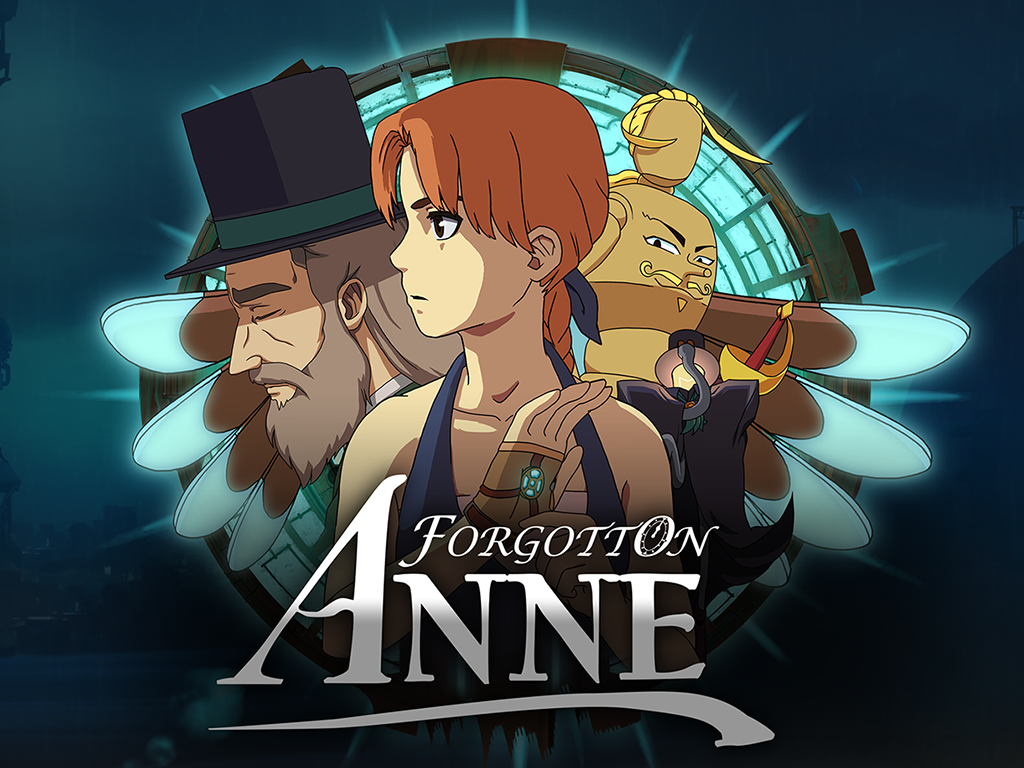 Imagine a place where everything that is lost and forgotten goes; old toys, letters, single socks. The Forgotten Lands is a magical world inhabited by Forgotlings; creatures composed of mislaid objects longing to be remembered again.
|
| Game 12 | HoloLAB Champions  HoloLAB Champions is a virtual reality (VR) chemistry game show, where players complete lab experiments to become champions of lab practice. In the game, players interact with materials that replicate the equipment and materials of a real chemistry lab, allowing them to learn and practice real lab skills in a safe environment. Designed for the HTC Vive headset and hand controls, this Unity game was developed with input from high school chemistry teachers and students. It recreates real experiments with tangible interactions (like scooping, pouring, and measuring), as well as tools and machines (like goggles and a scale), in a completely immersive 3D environment. In this virtual reality game show, contestants must finish experiments quickly and accurately, with guidance and witty commentary provided by the holographic hosts Earl and Meyer. HoloLAB Champions was created through support by the Institute of Education Sciences (part of the U.S. Department of Education) and the Small Business Innovation Research (SBIR) program. |
| Game 13 | LigandQuest (student-created game)  LigandQuest is a game designed to teach the core concepts of pharmacology. The game was created as a result of a collaboration between faculty and students from the School of Nursing, the Frank H. Netter MD School of Medicine, and the Game Design and Development program at Quinnipiac University. |
| Game 14 | Machine-Machine (student-created game) 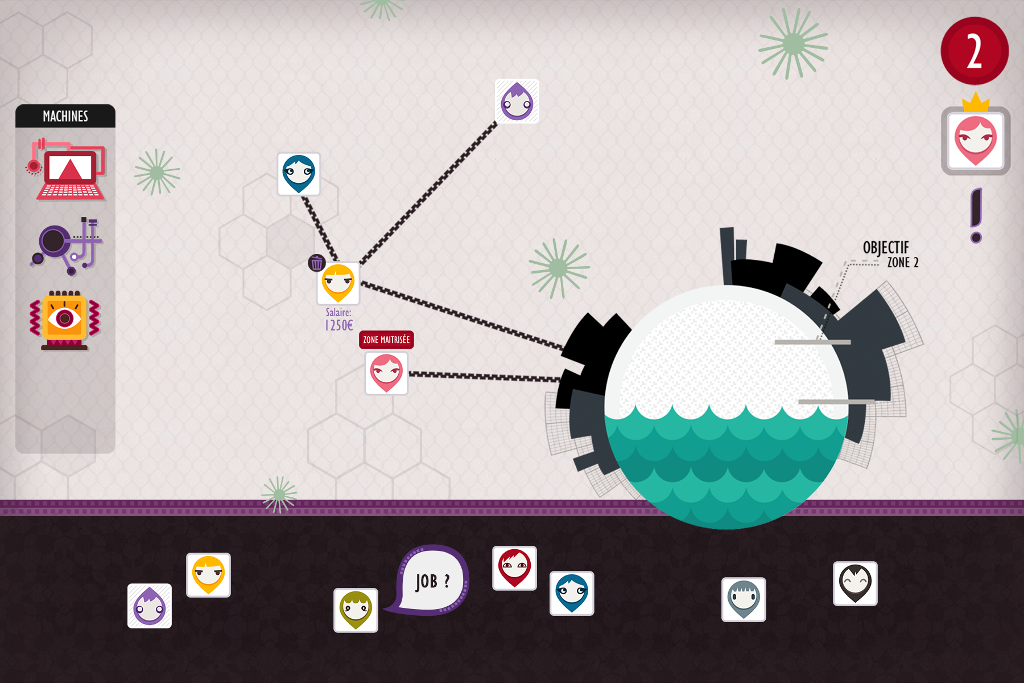 Machine-Machine is a game portraying the white-collar workers in ICT as a new form of working class created through the simplicity and repetitiveness of the tasks assigned to the employees in the oppressive open space. Via the system rhetoric, the game show us also the malicious functioning of human resources management through the competition between workers, the self-surveillance and acceptance of wage reductions and bad working conditions in a society with a high level of unemployment and precariousness.
|
| Game 15 | Marriage game: Playing with Love Marriage has historically involved the selling of women for profit, the trading of daughters for property, used as a legal justification for rape and domestic abuse, limited access to family services, spawned a billion-dollar slave industry around diamonds, and created the backbone for much of the American Dream. To explore the marriage-industrial complex and its historical evolution, this project utilizes serious games and critical play to question the seemingly natural social institutions that individuals participate in every day.
|
| Game 16 | Nu:ya! Nu:ya! A Tuscarora Exploratory Game (student-created game) 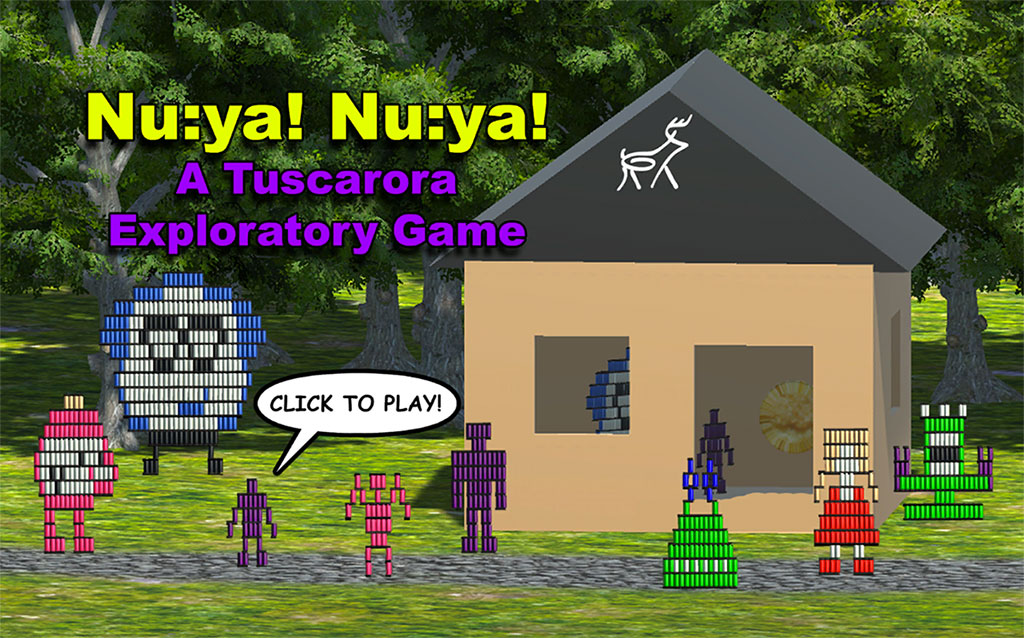 Nu:ya! Nu:ya! is a 3D exploratory game that seeks to reaffirm the importance of our matrilineal governance through our clan system through the simulation of Nu:ya, a practice in which we recognize our paternal lineage for one day of the year and strengthen our relationships with our extended families and Nation. |
| Game 17 | Paparazzi 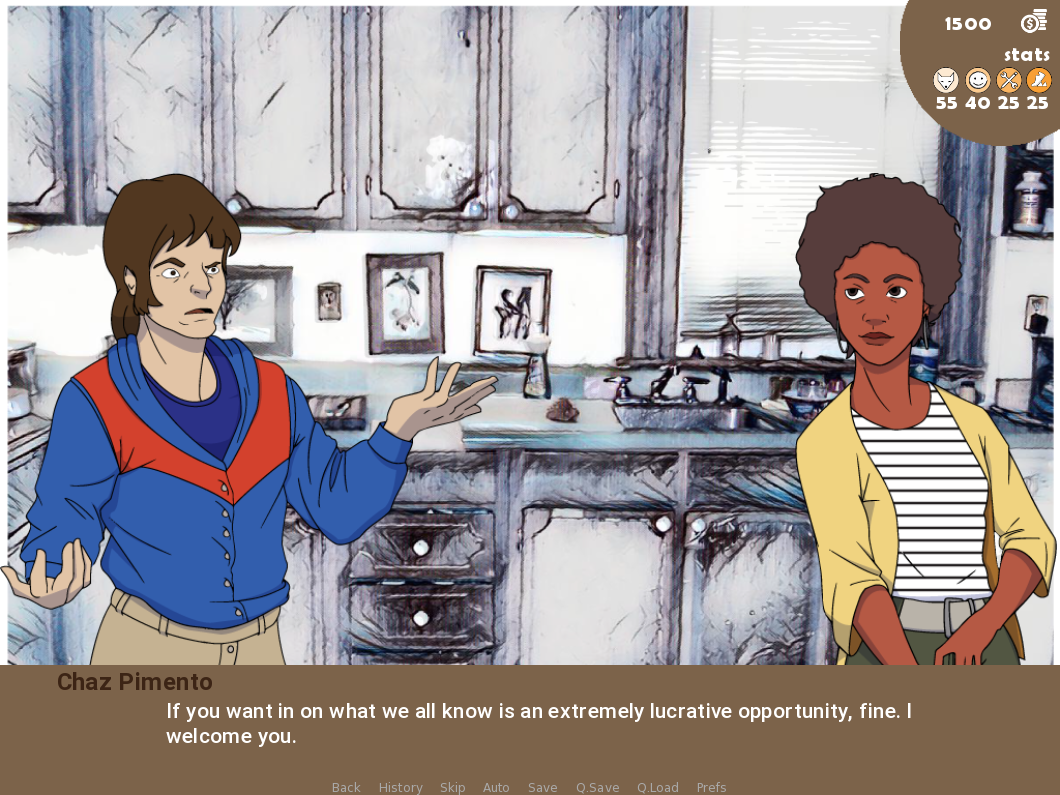 Paparazzi is a visual novel game w/ light RPG elements intended to explore the murky world of paparazzi journalism. This is a slice of the game midway through the story. |
| Game 18 | paranismo (student-created game) 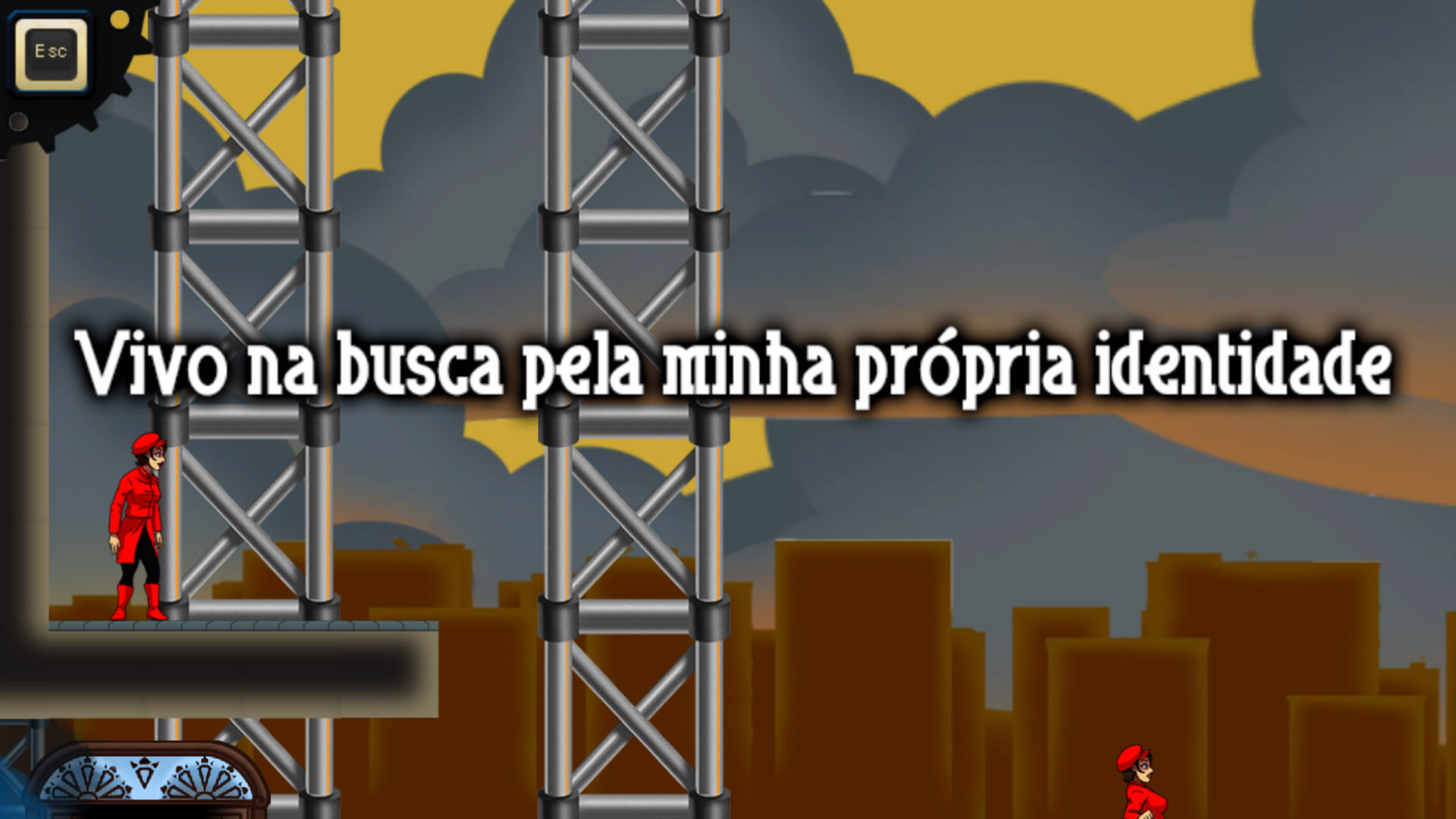 Educational, Leisure or Art game? This game works as follows: "A young artist ventures into the city, trying to find her artistic personality, and is faced with Paranism, in which she immerses herself, trying to fit her concepts, which come to influence the architecture and local art".
|
| Game 19 | Plunder Panic 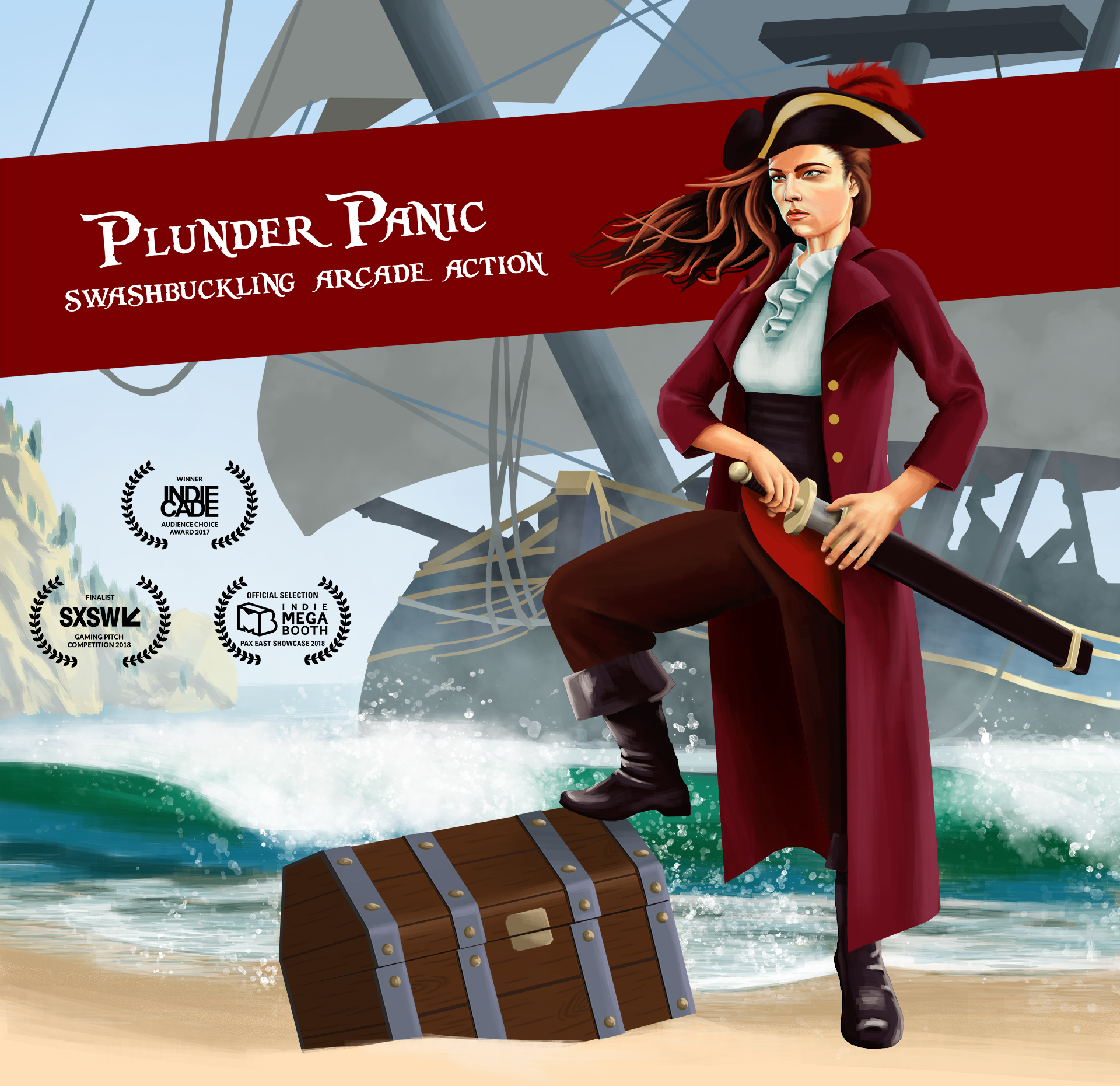 Plunder Panic is a swashbuckling, 12-person multiplayer arcade game where two rival crews battle for supremacy on the high seas. Defeat the enemy captain, scuttle their ship, plunder enough booty or end up shark bait in Davy Jones' Locker! |
| Game 20 | Tell a Dandelion a Secret (student-created game)  A short but relaxed and thoughtful game urging you to know yourself. |
| Game 21 | To Be A Whale  "To Be A Whale" is an educational adventure game where players learn to code as they control the movements of a whale with text commands. |
| Game 22 | Umbrella Mondays (student-created game) 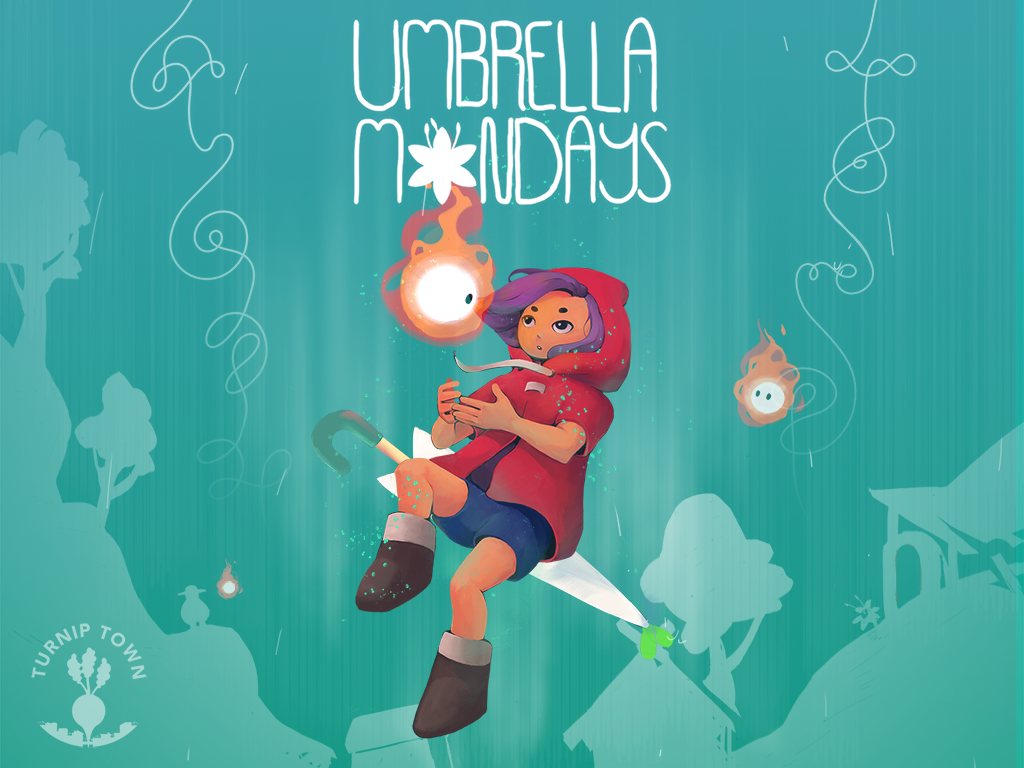 Umbrella Mondays begins on a rainy morning when a little girl named Fella awakes, finds a journal, and journeys to explore a beautiful ruin of mystical wonder. Players of this 3D puzzle narrative game help Fella protect adorable fire spirits with her umbrella, solve puzzles and unlock clues along the way about the significance of the green rain and Fella's missing memories. |
| Game 23 | VESTA Virtual Vineyard  The Virtual Vineyards project is exploring innovative approaches to providing viticulture and enology education to professionals through the use of virtual reality and web technologies.
|
| Game 24 | VRDrummer (student-created game) 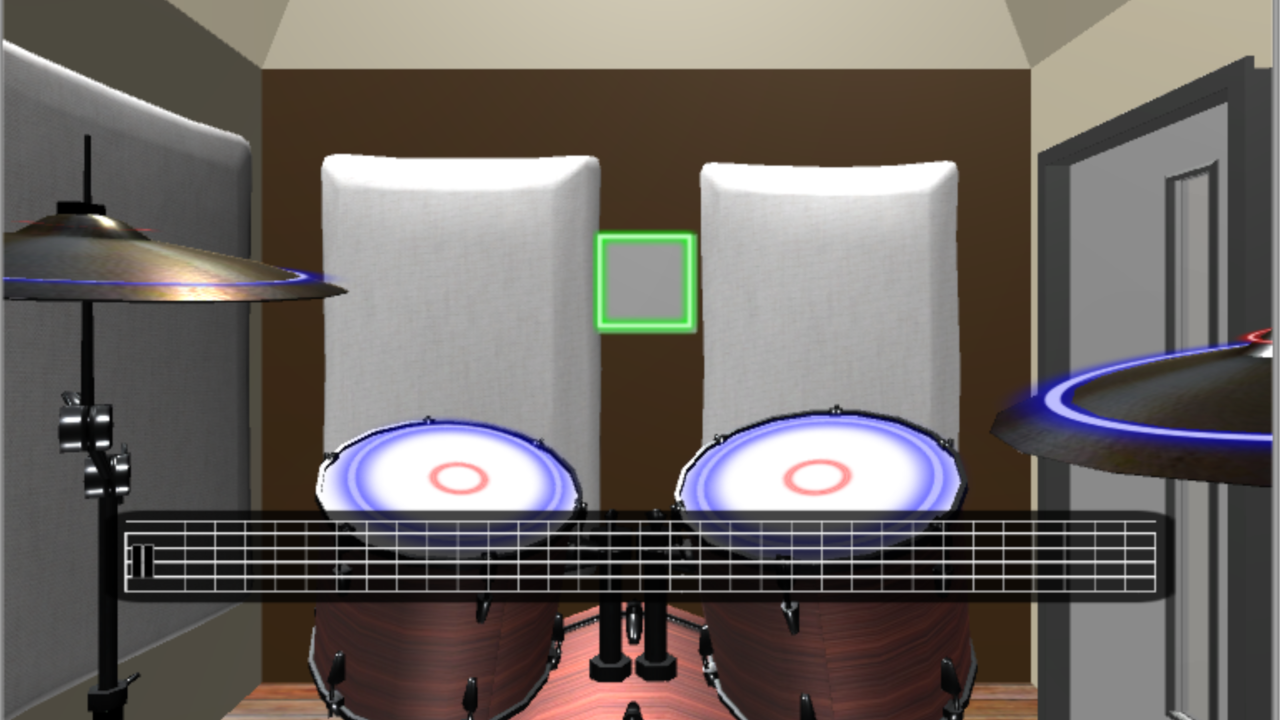 VR Drummer is a drumming environment created for drummers who have lost the use of their arms or hands. Completely hands free, you can play in real time or create jams beat by beat and play it back in regular speed. Created for a specific person who is unable to hold drum sticks any more. This is a great example of accessibility and is very fun to play!! |
| Game 25 | Ękwehę:we: The Real People (student-created game)  An in-development video game placed in contemporary Tuscarora territory. The gameplay is designed to encourage youth and members of the Tuscarora community to engage with their land and cultural knowledge, while emphasizing their own human abilities. |
Exhibited Non-Digital Games | |
| Game 1 | DreamWalk  DreamWalk - a Mythical, Storytelling, Role-Playing Game
|
| Game 2 | Eradicate! 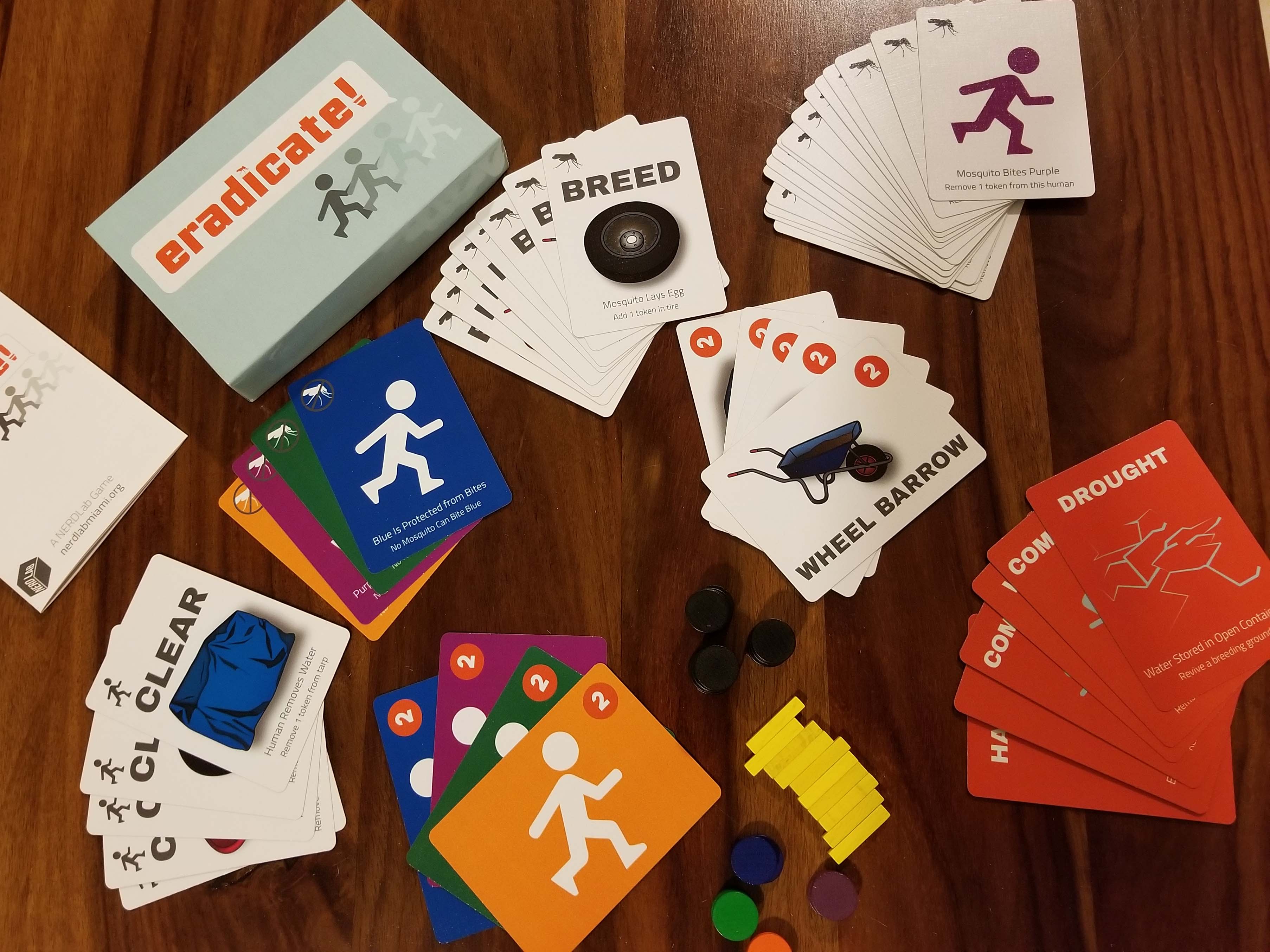 Eradicate! is a single player card game that you play as a human in charge of a village defending your people and clear breeding grounds filled with mosquitoes. The single-person card game is an offshoot of Human vs. Mosquitoes and was developed to emphasize learning through a first person, human-centric perspective. Eradicate! teaches about the transmission of vector borne disease passed through mosquitoes while also introducing ways to prevent habitat and mosquito population proliferation. It is meant to act as a starting point for conversations both in a classroom or workshop setting.
|
| Game 3 | Fellowship of Fools We are all Fools on our journeys through this world. It's dangerous to go alone. Take this game with you. Fellowship of Fools (FoF) is a game about relationships. Making friends takes time, communication and honesty. For many, making friends and forging new connections can be difficult or even feel impossible. FoF is a game that gives you an opportunity to get to know people through conversation, vulnerability and finding common ground. It is also a game about saying, yes, no and maybe.
|
| Game 4 | La Mancha 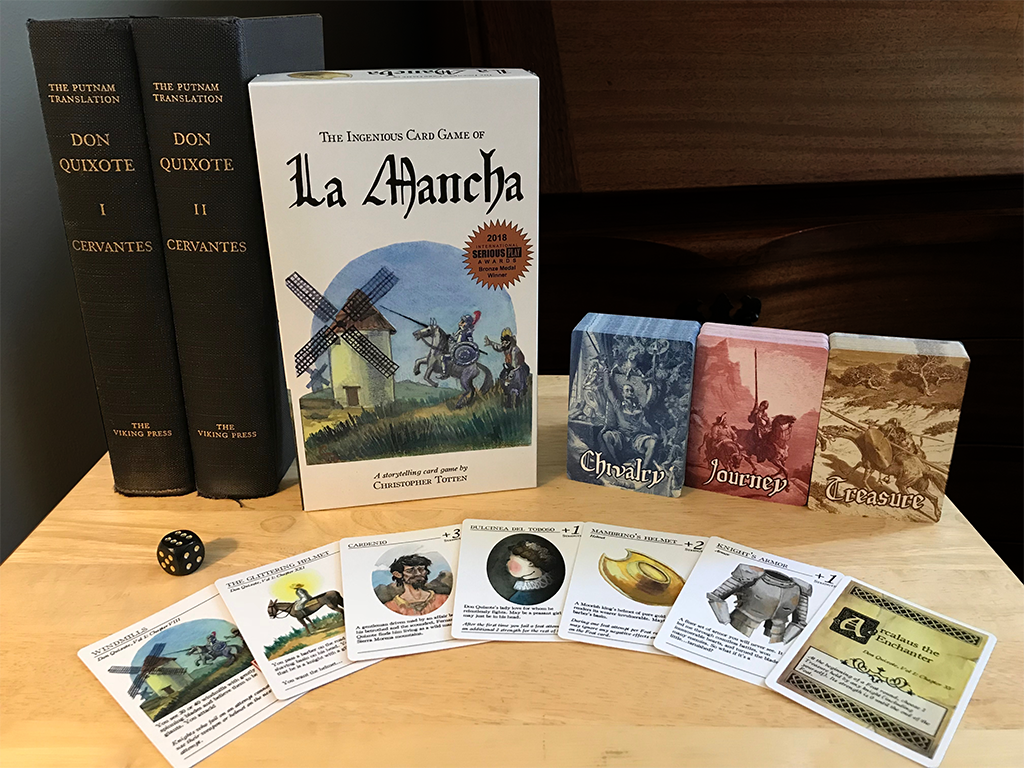 The literature-themed card game, La Mancha, is based on Miguel de Cervantes's classic 1605 novel, Don Quixote, which describes a nobleman playing at knighthood after reading too many books about chivalry.
|
| Game 5 | Lost & Found 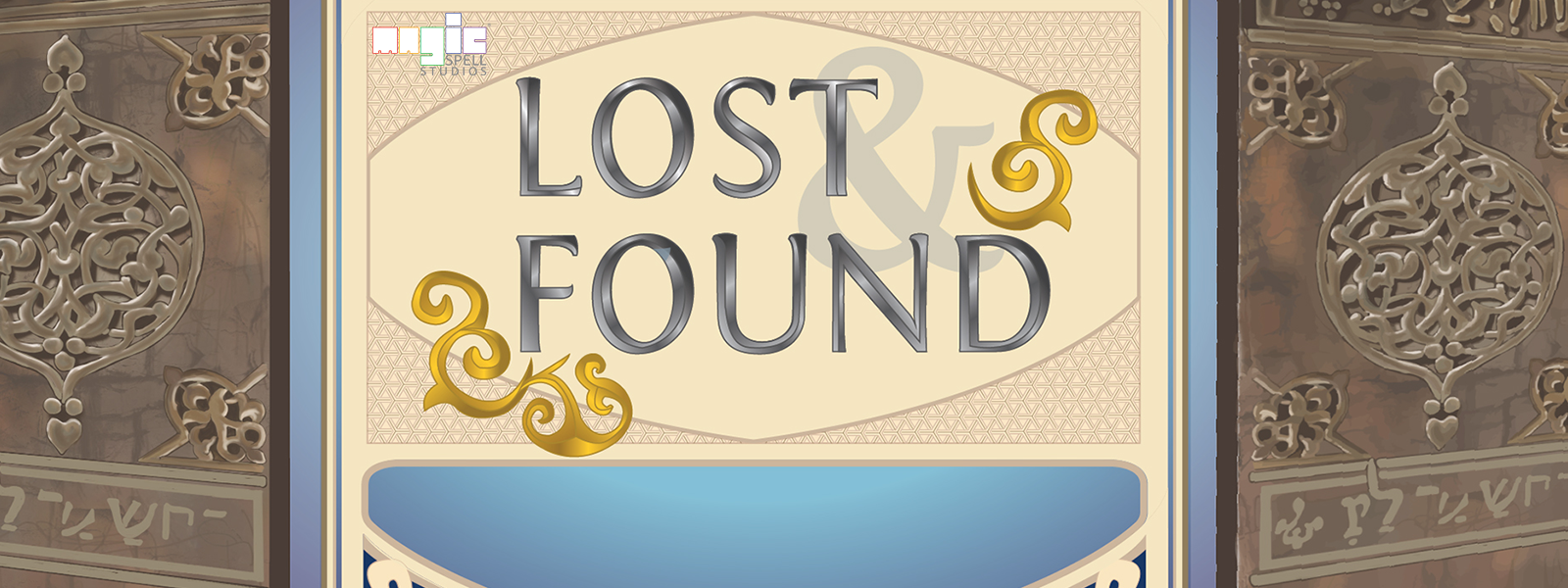 Lost & Found is a strategy card-to-mobile game series that teaches medieval religious legal systems with attention to period accuracy and cultural and historical context.
|
| Game 6 | Lost & Found: Order in the Court - the Party Game 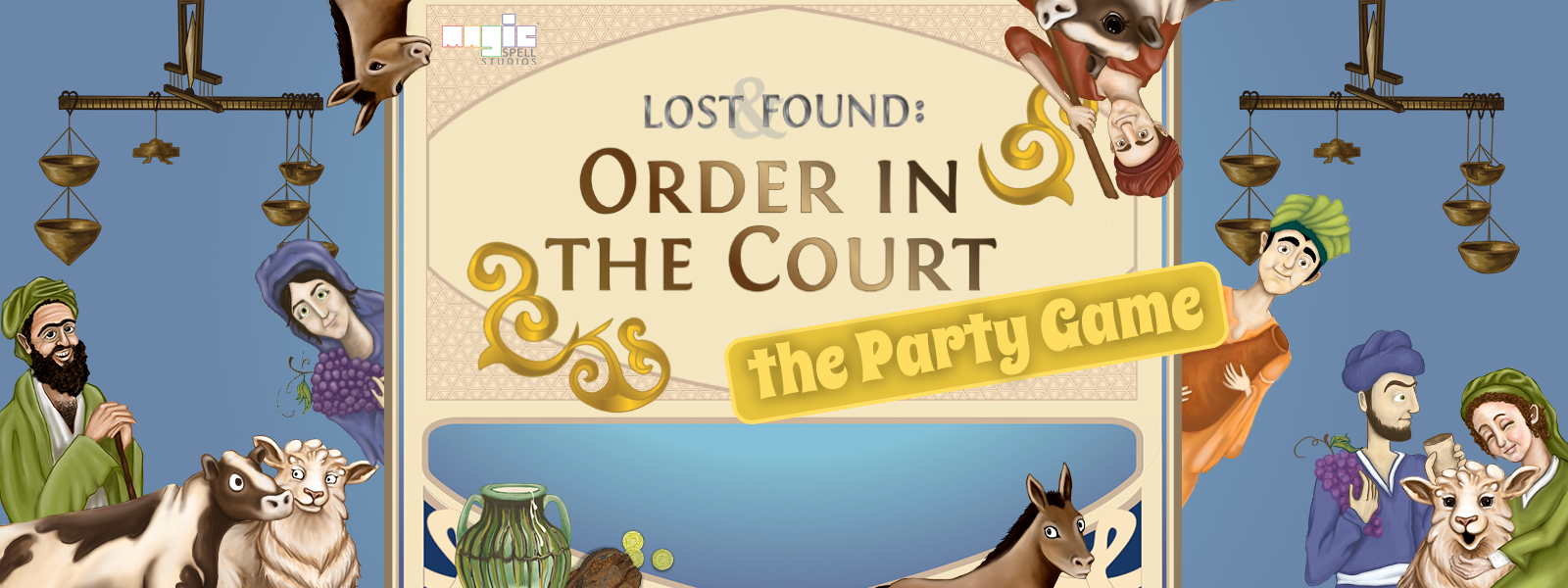 Lost & Found is a strategy card-to-mobile game series that teaches medieval religious legal systems with attention to period accuracy and cultural and historical context.
|
| Game 7 | Mill Makers: Build. Break. Fix. 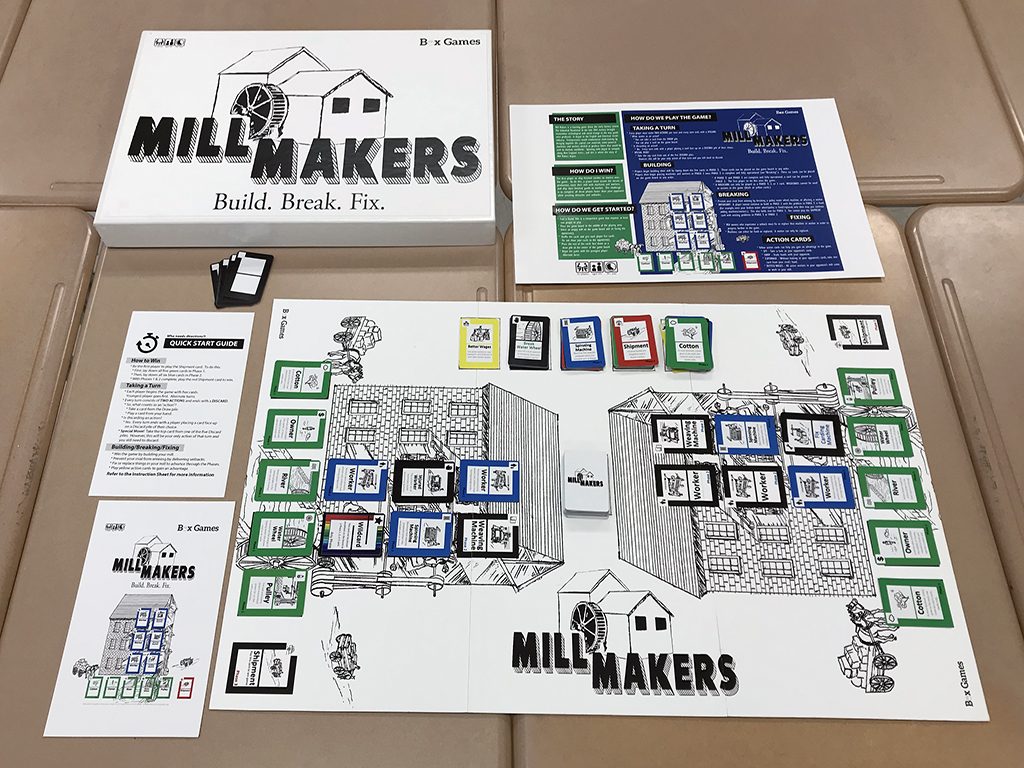 Mill Makers is a learning game about the early factory system. The Industrial Revolution in the late 18th century brought tremendous technological and social change in the way goods were produced. Entrepreneurs in the textile industry would revolutionize cloth-making by bringing together the capital, raw materials, water-powered machines, and workers needed to produce fabric that would be sent to markets worldwide. Spinning mills began competing along New England rivers... and this is where Mill Makers begins. The gameplay progresses through the construction of a textile mill in three phases: 1) acquiring the means of production, 2) stocking the mill with machines and workers, and 3) shipping the goods to market. The challenge is to complete all three phases faster than your opponent while avoiding various obstacles and setbacks. |
| Game 8 | Miner Madness, Dig into Code Theory (student-created game) 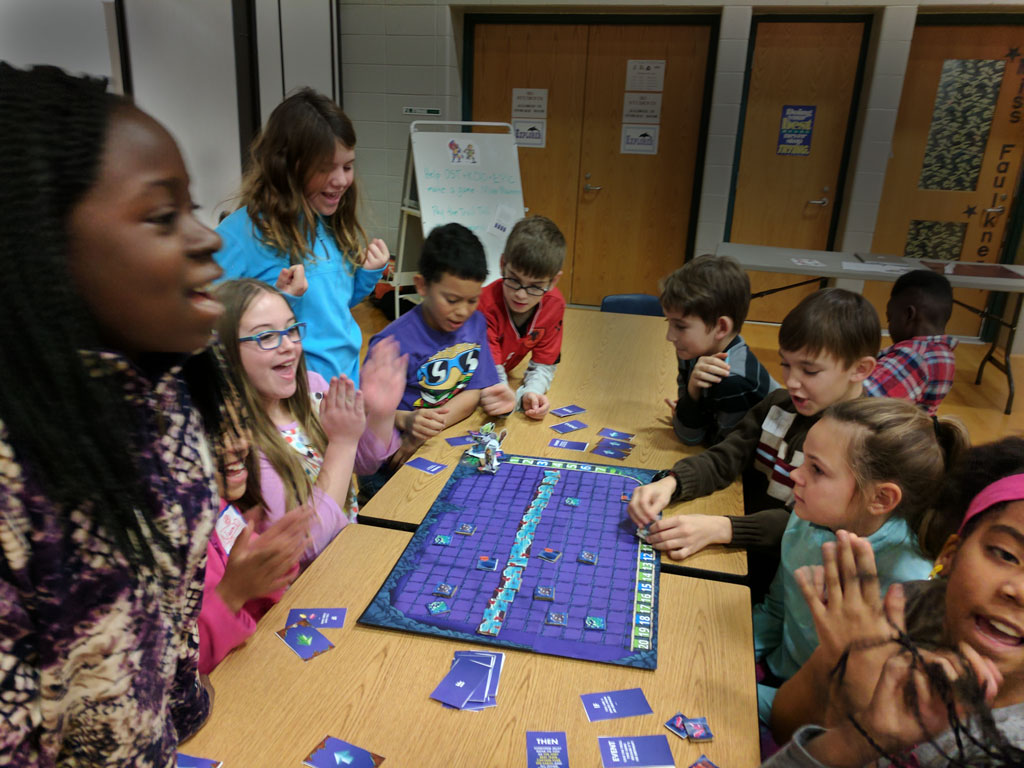 Miner Madness is a co-op board game aimed at teaching logical thinking and code theory. The players act as a team of miners that must navigate obstacles and avoid danger to dig up hidden treasures deep within the earth. Keys to successful gameplay include communicating with other team members and creating functions to enhance the game and progress faster.
|
| Game 9 | Rosenstrasse 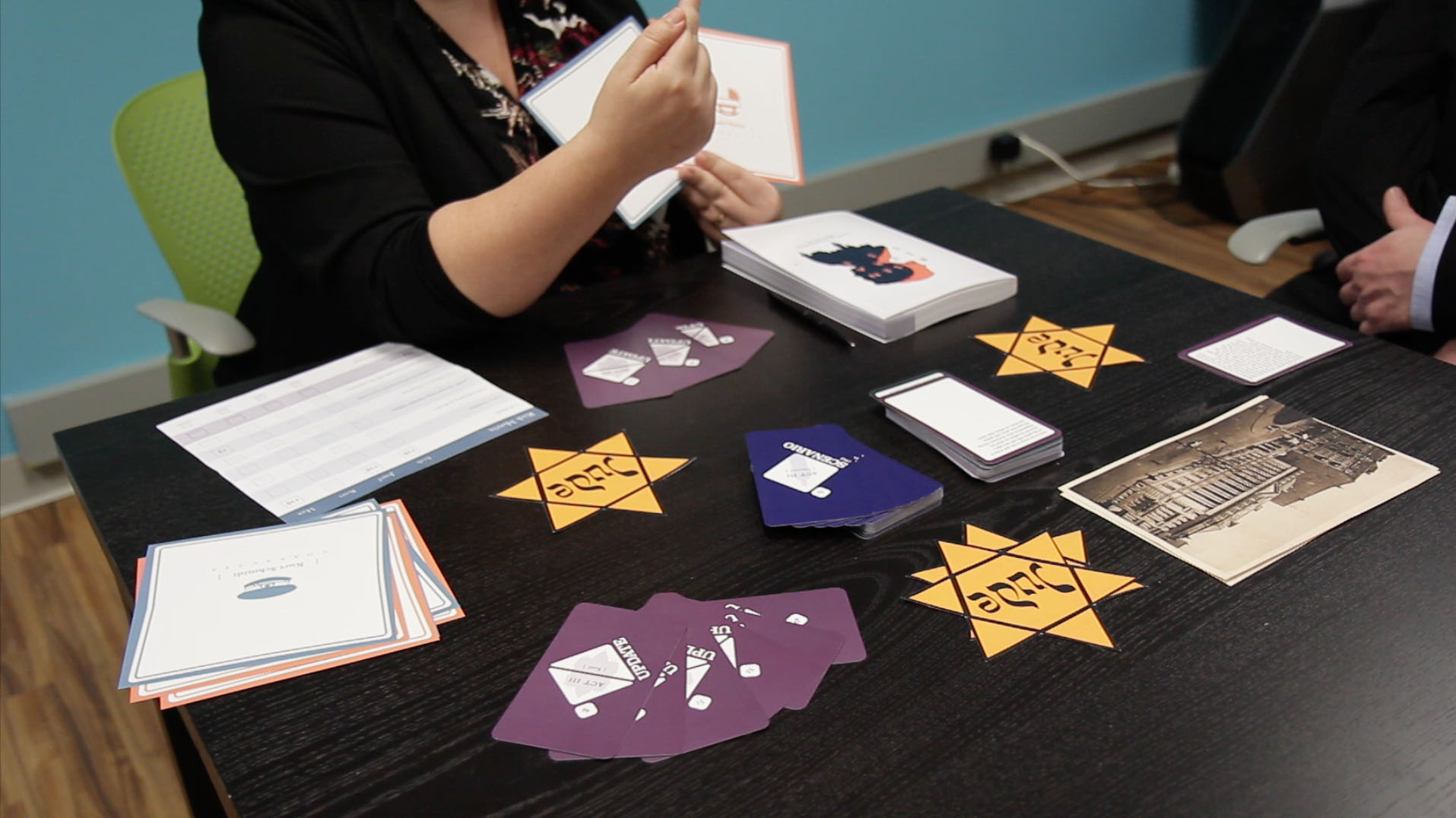 1933: Berlin, Germany
|
| Game 10 | Tides of Trade (student-created game) 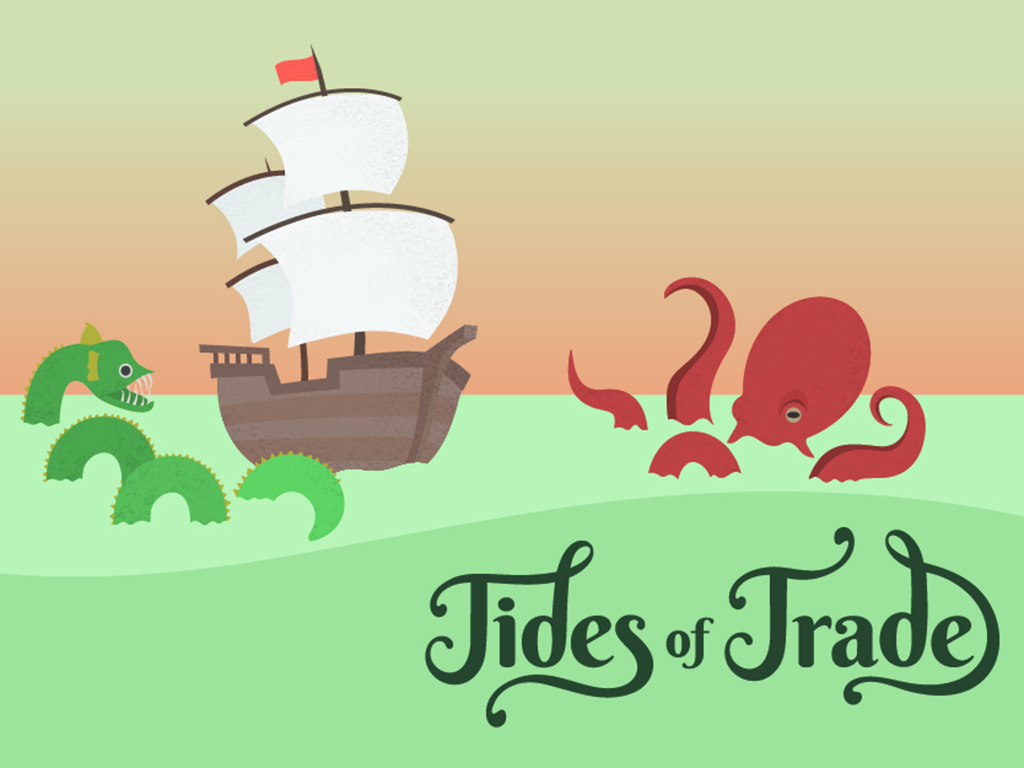 Tides of Trade puts players in the shoes of a trader trying to make a living during the treacherous Golden Age of Piracy. Players venture across the Caribbean, competing to obtain goods from the different islands while avoiding the threats that lurk at sea. It was created for the University of Miami Lowe Art Museum's "Antillean Visions: Maps and the Making of the Caribbean" exhibit as an interactive feature for visitors. It is inspired by The Pirate and Traders of the West Indies, a game published by William Spooner in 1847, which was showcased alongside Tides of Trade. |
Friday, October 12, 8:00a-9:00a
Registration Check-In and Continental Breakfast | |
| Location | Lobby (2nd floor of the MSU Union) |
| Description | The registration table is outside of the ballroom on the second floor of the MSU Union building.
NOTE: The registration table will be open across the conference day. The breakfast is sponsored by the Michigan State University Department of Media & Information. |
Friday, October 12, 9:00a-10:00a
Six Observations on Failure that May or May Not Relate to Games | |
| Location | MSU Union Ballroom |
| Format | Keynote |
| Presenter(s) |
|
| Description | Failure--the real F word if ever there was one--is a topic seldom discussed. But without failure, we wouldn't have a lot of other things we value: creativity, learning, and play, to name a few. This talk bravely journeys into the land of failure, with stops at an Irish quip, a phone dialed with a piano, The Onion's investigative research into failure, the Institute of Failure, the village of Intelligent Failures, and a couple of 19th century self-help books. |
Friday, October 12, 10:00a-10:30a
Break
Friday, October 12, 10:30a-11:30a
The Unbearable Lightness of Being Social Impact Games | |
| Location | MSU Union Ballroom |
| Format | Speaker |
| Presenter(s) |
|
| Description | If all games have meaning, what does it mean to be a social impact game? While we have in the past decade championed a variety of terms that orbit this concept of social impact, how do we, as researchers, designers, and players understand the edges of a social impact game and other types of playful design? How does intention and the reality of play intersect to support or detract from this concept of a social impact game? Whether it is a newsgame developed by a major news organization, an advergame designed by a marketing group, or a game with strong political implications made by a single independent artist, it's useful to examine what is meant by social impact and how the practice of creating social impact games can proceed in the future. |
Alternate Reality Games | |
| Location | MSU Room |
| Format | Papers |
| Paper 1 | Designing Context-Sensitive Geolocative Moderated Group Activity Games We present two case studies in the design of context-sensitive geolocative mediated group activity games. These are games that: use geolocation as an input mechanism; are constrained to be playable only in a specific geographical location; whose design is infused with the history, culture, or other qualitative features of the location; and whose primary gameplay exists between the players and their surroundings, mediated by a minimal software system. The two case studies cover Spirits at Prairie Creek Park and Fairy Trails and include an analysis of their requirements, constraints, design process, technical implementations, and informal evaluations. We discuss the benefits and drawbacks of this genre of games, relating both to the case studies, related work, and literature on games and play, as well as the implications of this work for future research. |
| Paper 2 | Designing Educational Alternate Reality Games: Introducing the Maquette Design Framework We present the Maquette Framework for designing educational Alternate Reality Games (ARGs). The framework synthesizes prior ARG literature and integrates the authors' experience designing and running three different ARGs with over 4,000 players. The Maquette Framework can be used generatively (to help create educational ARGs) or analytically (to review existing ARGs). The framework is represented by a table with four foundational pillars (audience, learning outcomes, setting, and This is Not a Game). A tabletop represents the narrative theme, upon which rests a three-dimensional model (i.e., maquette) game world that represents the pervasive transmedia interface of the game. Upon the game world are players, gamerunners, and fictional characters; activity diamonds consisting of learning activities, learning goals & assessment, educational scaffolding, and game mechanics; and story fragments. Player trajectories are various pathways that players take through the maquette. Elements and their relationship to one another are explained and illustrated with examples. |
| Paper 3 | Driving the Bus: Designing Educational Alternate Reality Games for Reusability Because alternate reality games (ARGs) are so time- and cost-intensive to produce, educational ARGs must be designed for reusability. We present a design framework for reusability centered on the objectives of adaptability, extensibility, and replayability. We then illustrate the use of this design framework with a case study of our ARG The Tessera, a ghost story designed to teach teenagers computational thinking skills and dispositions. By including narrative-driven calls to action and in-game communication for adaptability, an extensible participatory narrative, and the ability to replay levels to collaborate with and coach peers, The Tessera enables players to "drive the bus" of their own learning. |
Using Meditation to Explore Workshop Participants' Personal Experiences of Meaningful Play | |
| Location | Huron Room |
| Format | Workshop |
| Presenter(s) | Carrie Heeter |
| Description | People who come to the Meaningful Play conference share a deep love of games and the magical idea of play. The nuances of what each of us loves about games and play are personal and unique. This workshop will use meditation as a tool for attendees to connect with and explore nuances of their personal player experiences. In facilitated discussions after the meditations, participants will share what the meditation was like: what happened for you, what you discovered or remembered, insights and questions. As a group we can notice common themes and also distinct individual differences. |
Achievement unlocked? Exploring the Complexities of Empathy in Games | |
| Location | Superior Room |
| Format | Panel |
| Presenter(s) | Matthew Farber, Paul Darvasi, Karen Schrier, Liz Owens Boltz, and Kelli Dunlap |
| Description | Of all the social and emotional skills video games might support, empathy has perhaps garnered the most attention, and the most hype. But what is empathy, really, and how easy is it to move the needle on players' skills in this area? The panel members will dissect prevalent beliefs and debunk myths related to empathy in games, as well as discuss their own research, relevant case studies, and practical applications -- all of which take into account how tricky it can be to "do empathy" in games correctly. Some questions they'll explore: Are games/VR really the ultimate "empathy machines"? Are player agency and interactivity the keys to empathic connection in games? Is "walking in an avatar's shoes" the most impactful way to build player empathy? Can video games increase players' capacity for empathy? How might games fit within an instructional model designed to support or promote empathy? Are games really more "powerful," empathy-wise, than other forms of art and media like film, literature, and theater? |
Encouraging Curiosity and Exploration through Text and Narrative in Outer Wilds | |
| Location | Lake Michigan |
| Format | Speaker |
| Presenter(s) | Kelsey Beachum |
| Description | This talk will discuss the role of narrative and text in achieving Outer Wilds' original design goal over the course of its development, beginning in with its inception in 2012 as a student thesis, through its development at Mobius Digital after winning the Seumus McNally and Best in Design awards at the 2015 Independent Games Festival, and finally ending with its 2018 release through Annapurna Interactive. In particular, this talk will address the challenges of writing for an open-world game and in telling a linear story through a non-linear delivery, given a lack of control over players' entry point into the game's main story. It will break down specific design choices, including how we were able to gate text we wanted players to encounter later on using the star systems' layout and planetary terrain. |
Cooperative Play | |
| Location | Lake Ontario |
| Format | Papers |
| Paper 1 | Learning the Art of Herding Cats: The Development of Leaders in MMO Groups TPlayers of digital games are increasingly facing the necessity to joining organizations to accomplish tasks. They may feel social ties to others within the group and need to help other team-members in order to pursue goal tasks. As engagement increases, so does the likelihood that the player will become a leader of their organization. Research into leadership in online games indicates that leadership in-game teaches skills useful in out-of-game contexts. Even when they do not wish to engage in leadership roles, obligation to one's organization can cause these players to "step up" and learn these skills.
|
| Paper 2 | The Loss of Sociability Online in MMORPGs As Displayed by Final Fantasy XI The rise of toxic gaming culture occurs in concurrence with the slow loss of technological affordances that promote sociality and cooperation in Massively Multiplayer Online Role-playing Games (MMORPG). Between 2004 - 2013, World of Warcraft slowly removed the need for players to interact with one another. This resulted in other MMORPGs following suit with existing MMORPGs left to figure out how to deal with this new style of play. This case study examines the patch notes and FFXI software history of the popular MMORPG called Final Fantasy XI Online (FFXI). This MMORPG is unique as it was a game whose systems forced cooperation and reliance on other people. How FFXI changed from forced human-to-human reliance to a single-player experience is a unique case study reflecting the broader design trends in socially-oriented online play. By explicating these features, this case study provides useful context the study of the loss of cooperation and sociability in online gaming. |
| Paper 3 | Player-roles in Massively Multiplayer Online Role-playing Games, and Perceived Skill and Relationship Benefits, Diverge with Social Attitudes and Political Ideology Little is known about how players' choices within MMORPGs reflect social values and attitudes, and political ideology. We surveyed 5,847 players of Jagex's Runescape to examine social value orientation, hostility, and liberalism-conservatism. Players reported predominantly prosocial orientations. However, those who prioritised skill acquisition/improvement (Skillers), combat (Killers) and narrative challenges (Questers) differed in broader socio-cognitive factors. Killers were the most likely to show individualist and competitive values, report the most hostility to others and the most conservative political ideology. Questers reported the least hostility and most liberal outlooks. Players identified as individualists reported the weakest benefits of MMORPG play; the most hostile players (self-) reported the strongest. Players with libertarian outlooks reported the strongest benefits while those with liberal-left outlooks reported the weakest. These findings offer new perspectives on the socio-cognitive processes of MMORPGs, and inform discussion of how players derive leisure, education and social capital benefits from MMORPG play. |
Friday, October 12, 11:30a-1:00p
Birds of a Feather Lunch (on your own) and Industry/Student Meet'n'Greet | |
| Location | |
| Description | LunchFriday lunch is not provided. Take this time to socialize with your fellow conference attendees while enjoying the many dining venues within downtown East Lansing.If you are interested in lunching with like minded individuals, there will be Birds of a Feather meet-up signs in the lobby. Meet at one of the signs and go to lunch together. The groups include:
Industry/Student Meet'n'GreetFrom 11:30-12:15 is an Industry/Student Meet'n'Greet in the Ballroom. If you are a student interested in talking with some of the companies attending Meaningful Play, please come and bring your business cards, resumes, or portfolios. If you are a company interested in meeting some talent, please come ready to discuss opportunities at your company and/or job seeking advice. |
Friday, October 12, 1:00p-2:00p
Getting Teachers to Drink the GBL Kool Aid | |
| Location | MSU Union Ballroom |
| Format | Speaker |
| Presenter(s) |
|
| Description | How are educators using games in their classrooms to give students agency, while also teaching skills such as empathy, design, and systems thinking? This question has motivated Dr. Farber's research about educators who are experts of game-based learning, and now informs his current inquiry into teachers who view themselves as learning designers. This presentation will: a) share findings from Dr. Farber's recent book, Game-Based Learning in Action; b) review the development of his teacher education courses, each of which integrates constructionism, where students experience and then design personally meaningful artifacts (Papert, 1993); and c) preview forthcoming research about the social practices of educators in the 2018 cohort of Global Minecraft Mentor community. Dr. Farber will also comment on promises and challenges of game-based learning in practice, and how games can be children's machines, not teaching machines. |
Teaching Game Design | |
| Location | MSU Room |
| Format | Papers |
| Paper 1 | Active Learning and Gamification in Game Design Courses Engineering instructors often rely on the traditional lecture model where they lecture on a topic, with or without a slideshow, to a classroom of students. Student engagement is low or non-existent with students neglecting to engage with the material until an assessment (i.e. an assignment or examination) is due. Further, students often do not get much practice soft-skills that are critical for successful professional interactions in industry practice and future academic work in lecture only courses. However, there have been alternative approaches proposed to help address the engagement and skill gaps. We describe our experiences in revising two game design courses at the University of Michigan - Dearborn where we replaced a traditional, lecture-heavy, course delivery model with one involving active-learning, role-play, and gamification. We track a cohort of students through a two-course game design sequence and report our findings from daily and term assessments. |
| Paper 2 | EOTA: A Method For Improving Peer Feedback in the Game Design Classroom Peer feedback is an essential part of the iterative game design process. Peer feedback requires students to develop a range of skills, both to provide high quality feedback to others and to reflect on the feedback they receive. Students also often engage in reflection activities as a team, requiring even more skill development for effective peer feedback exchange to occur. Students often struggle to develop the skills necessary for giving and receiving feedback effectively. This paper presents the EOTA method, a pedagogical approach designed to elicit formative feedback during in-class playtests of student games. We discuss our experiences using the EOTA method in university-level game design classes and identify how the EOTA method can help address issues that often arise in peer feedback exchange, such as supporting student engagement, improving quality of student feedback, and helping students reflect on feedback received. |
| Paper 3 | This is How We Roll; A Play on Creative Thought and the Generation of Novelty This paper examines generation of novelty and creative dynamics in design teams that aim at arriving at something truly novel. Looking at the works by Schumpeter, Campbell and March in explorations for solutions that go beyond what could be easily foreseeable and the works of Smith, Lindsey, Cardoso among others, in the field of design fixation, this paper explores an approach taken to introduce elements of randomness in design exercises to prevent fixation and facilitate aimless and unguided explorations. The dynamic explained in this paper presents the use of a game-based dynamic in design teams that facilitates the generation of novel ideas. |
Gamedev Community Development 101 | |
| Location | Huron Room |
| Format | Roundtable |
| Presenter(s) | Mars Ashton (moderator) |
| Description | Game Development communities form the bridge between talent and employment and students and professionals. They define an area's ability to collaborate, bring like-minded individuals together and elevate businesses. In this talk, explore the past two years of the 400+ member International Game Developers Association Ann Arbor Chapter that has 50+ attendees on average, the opportunities that arose from it and how to create something like it yourself! Discuss other local organizations, their successes and lessons learned, in order to get involved, start something new and tap into Michigan's amazing collection of talent, industry and heart. |
The Art of Serious Game Design: A methodology and practical guide for serious game design within multidisciplinary teams | |
| Location | Superior Room |
| Format | Panel |
| Presenter(s) | Leonora Zefi, Naza Djafarova, Dr. Tony Bates, Dr. Alexander Ferworn, Dr. Ozgur Turetken, Dr. Daria Romaniuk, Dr. Paula Mastrilli, Dr. Anastasia Dimitriadou and Margaret Verkuyl |
| Description | This presentation will focus on the methodology followed to create a game design guide aimed at helping multidisciplinary teams during the pre-production stage of designing a serious game. The design methodology to be presented is anchored on the Design Play Experience (DPE) framework developed by Brian Winn (2009). The participants in the session will learn how this methodology can help to streamline and enhance communication and idea generation among their own design teams.
The speakers will share the feedback from workshops during which this methodology was tested, highlight the value identified by the workshop participants and discuss the lessons learned from the exploration process and workshop facilitation. The Art of Serious Game Design Guide research project was funded by eCampus Ontario and is freely available as an Open Educational Resource and can be accessed at https://pressbooks.library.ryerson.ca/guide/ |
The Original Mobile Games: Recreating Historic Dexterity Puzzle Games For Digital Mobile Platforms | |
| Location | Lake Michigan |
| Format | Speaker |
| Presenter(s) | Stephen Jacobs |
| Description | "The Original Mobile Games" (TOMG) is a digital collection of historic handheld puzzle games from The Strong National Museum of Play. The genre became a popular culture phenomenon with "Pigs in Clover," which was the "Angry Birds" of 1889. More than ball mazes, these "dexterity games" also used equipment like jigsaw style puzzle pieces, dominoes, dice, "jumping beans" and more. They were often themed around political upheavals and/or popular culture phenomena and are played by tilting, shaking and/or tapping; acts that map well to today's mobile platforms. Students and faculty from RIT worked with The Strong to bring 27 of these historic games, background information on them, and photographs of each, to iOS and Android. TOMG was polished and released the with support from Second Avenue Learning, Inc. This post-mortem will cover the history and design of these original games, while examining the process, challenges and successes involved in shipping TOMG. |
Gaming in Context | |
| Location | Lake Ontario |
| Format | Papers |
| Paper 1 | Playing Incremental Games at Work As Relief? Maybe Not (Top Paper Award) Incremental game is a popular genre of games characterized by incremental progress incrementally with or without player input. Incremental games are often thought of as the perfect games to play at work since it does not interrupt work. Using an online survey of 466 incremental game players, this study seeks to examine to what extent does work-related stress predict incremental game playing behavior during work and outside of work. Moreover, does playing incremental games during work facilitate recovery from work-related stress? |
| Paper 2 | In recent years, children with communication impairments are increasingly interacting with mobile applications (apps) to work on communication and social skills under the guidance of their speech language pathologists (SLPs). Yet, limited research has been conducted to explore the collaborative use of mobile technology between them. Through interviewing 23 SLPs about their iPad use in the workplace, our study reveals that these SLPs use a variety of applications, including apps as assistive technology and mobile games as reinforcement and motivational tool for therapy. Specifically, app design recommendations reported by SLPs also closely align with prior research on usability, mobility, and playability heuristics for mobile games. This empirical study highlights adoption of commercialized games as a learning and rehabilitation tool in the clinical context, and calls for future research to translate user recommendations as design guidelines to support children with and without disabilities. |
| Paper 3 | Thinking Outside the Box: Video Game Play As Warm Up for Creative Thinking Does game play on improving participant's problem-solving ability, perspective shifting (using the Remote Association task), or change detection ability. These are common cognitive elements in video game play that relate to creative problem solving and have the potential to transfer to problems outside of video games. To address this questions, 62 participants were randomly assigned to either a Game (Roller Coaster Tycoon) condition or Control (filler task) condition and completed 3 tasks: a pre/post insight problem task, remote association task, and a change detection task. There was no difference in problem solving abilities at time 1 as expected, however participants in the game condition increased their problem solving ability at time 2 while those in the control condition did not. No differences between the conditions were found for the other two tasks. These data indicate that game play did not warm-up participants for either of these tasks, but did for the problem solving task. |
Friday, October 12, 2:00p-2:30p
Break
Friday, October 12, 2:30p-3:30p
Inclusive Game Design | |
| Location | MSU Union Ballroom |
| Format | Speaker |
| Presenter(s) |
|
| Description | What does it mean to "belong" when it comes to gaming? Are there types of designs, communities and play styles that are more exclusionary or inclusive? When we make a game that targets a certain demographic, do we also end up excluding some people? How do we make games that express our unique identities and perspectives, while also ensuring that everyone else feels like they "belong" in our game world? In this talk, I will share late-breaking takeaways from the work I am doing with the ADL's Center for Technology and Society on games and inclusion, bias reduction, and empathy. I will also provide recommendations that designers, educators, and researchers can use to help people feel more included in games and gaming communities. |
Innovation in STEM Games | |
| Location | MSU Room |
| Format | Papers |
| Paper 1 | BeadED Adventures: Using Tangible Game Artifacts to Assist STEM Learning This paper describes the design principles guiding the creation of a versatile STEM education digital game, BeadED Adventures. Like Loominary (Sullivan et al., 2018) from which we draw inspiration, BeadED Adventures introduces the tangible aspect of tabletop games into a video game. BeadED Adventures is an interactive narrative where players solve STEM-based puzzles and make choices affecting the narrative plot by creating a tangible learning artifact: a string of beads that can be worn as a bracelet or used as a keychain, bookmark, etc.
|
| Paper 2 | Hemonauts: Initial Implementation of Digital Games to Increase STEM Learning Among Chronically Ill Children (Top Paper Award) This study reports on findings from the first phase of the Hemonauts project, a suite of digital games intended to increase Science, Technology, Engineering and Mathematics (STEM) content knowledge in chronically ill children. Chronically ill children are at risk of falling behind in school due to disease implications, and potentially resulting in additional psychological complications and setbacks. Hemonauts seeks to leverages childhood diseases based on the target population's innate interest in anatomy and physiology. We created and tested a suite of game prototypes to engage children in challenges related to Sickle Cell Anemia. Participants were middle school students and pediatric patients with Sickle Cell Anemia. Patients with Sickle Cell Anemia demonstrated high levels of interest-driven engagement with content relevant to their diagnosis. However, at this stage, they did not demonstrate increases in STEM content knowledge and more generally, we found that patients expressed an alarmingly low level of disease literacy. |
| Paper 3 | Avatar Effects in a STEM-Game Website The STEM Game Crew was developed as a portal to online STEM games. The website was used to test the expectation that science-related (versus non-science related) avatars and avatar customization would enhance users' STEM attitudes (i.e., STEM-learning self-efficacy and STEM interest). Data collected in a Midwestern public middle school (N = 53) partially supported this expectation. Science-related avatars were associated with higher STEM attitudes for boys only. Unexpectedly, avatar customization was associated with lower STEM attitudes across gender. STEM attitudes were positively associated with avatar identification and avatar embodiment, though gender differences were observed. This study illustrates the potential benefits and limitations of utilizing avatars in educational game websites, but also provides insights into the ways that avatars can be designed to enhance student learning and motivation. |
| Paper 4 | Merging Education, Assessment, and Entertainment in Math Games: A Case Study of Function Force Games for education and games for entertainment tend to follow different development paths according to their respective purposes. Entertainment game development follows the traditional best practices of games design while educational game development adds an additional constraining layer of learning objectives. The contribution of this work is a case study of a game, Function Force, that was created with the entertainment and educational design goals given relatively equal weight. In this case study, the development of the game mechanic, puzzle designs, and game level progressions will be explained and connected to relevant educational and curriculum components. |
Looking for Group: Building Interdisciplinary Game Studies Communities | |
| Location | Huron Room |
| Format | Roundtable |
| Presenter(s) | Cody Mejeur, Kristopher Purzycki, Jonah Magar, Ronny Ford, Daniel Fandino, Krista-Lee Malone and Nathan Humpal |
| Description | Even at institutions where game and play studies have been embraced, it can still be difficult to navigate the interdisciplinary nature of the field: game studies work can take place in many different departments with different disciplinary commitments, service responsibilities, and teaching and research obligations that make it challenging to connect with and understand each others' work.
This roundtable examines the obstacles and opportunities present in building interdisciplinary research groups and communities in game studies across departments in higher education. By bringing together student and staff organizers from the Game Studies Guild at MSU and the Serious Play research group at UW-Milwaukee, the roundtable will share lessons learned in establishing cross-campus game studies groups at universities, future plans for supporting and expanding them, and concerns and hopes for the process. Discussion of each of these topics will present actionable advice with concrete examples for scholars, librarians, and teachers. |
Game Post-Mortem Microtalks I | |
| Location | Superior Room |
| Format | Microtalks |
| Microtalk 1 | The Scott Pilgrimage Project: Glocal Culture, Psychogeography, and Gaming the City The Scott Pilgrimage is a location-based game and city tour designed by a Toronto high school media studies class inspired by the Scott Pilgrim graphic novel series and major motion picture. Players use mobile devices to undertake a ludic walking tour of all the major locations of the story as they learn about Toronto cultural history. The project was inspired by the work of Guy Debord and the Marxist Situationists International's advocacy of using urban spaces in playful and unpredictable ways, emblemized in the concepts of psychogeography and the dérive. It is also points to media guru's Marshall McLuhan's vision of the city as classroom, and influential urban planner Jane Jacob's deep belief that a metropolis should be built for people and not cars. I will discuss the successes and challenges of designing a locative game with high school students, but also explore the theoretical underpinnings of the project and its implications for the future of education, tourism, civics, urban design and how we engage with our cities. |
| Microtalk 2 | A Pirates Life for Me: A Case Study of the Design, Development, and Deployment of Plunder Panic Plunder Panic is a swashbuckling, 12-person multiplayer arcade game where two rival crews battle for supremacy on the high seas. Defeat the enemy captain, scuttle their ship, plunder enough booty or end up shark bait in Davy Jones' Locker! The game was created by a team of faculty and students in the Games for Entertainment and Learning Lab at Michigan State University as a passion project beginning in May 2017. An early version of the game was shown as a sneak peek during the Traverse City Film Festival in July 2017. The game was debuted at IndieCade in October 2017 in Los Angeles and received the Audience Choice Award. The game was a finalist at the SXSW 2018 Gaming Pitch Competition and was an official selection in the Indie MEGABOOTH at Pax East 2018! Since PAX East, we have continued to develop the game and plan to bringing Plunder Panic to the world in late 2018. This talk will discuss the design, development, and distribution challenges in creating an award winning game within a university setting. |
| Microtalk 3 | Thunderbird Strike: Sovereign Game Development Without Borders Thunderbird Strike is a 2D game which brings awareness to Indigenous perspectives on oil infrastructure by adapting Anishinaabe stories about thunderbirds into game design and mechanics to express the need for balance. Players are challenged to make choices for restoration or destruction during a revisioned retro style side-scroller. As an Indigenous-led game, Thunderbird Strike is an act of sovereignty which has drawn considerable attention and exemplifies the importance of self-determined games. |
Exploring Theme in Meaningful Games | |
| Location | Lake Michigan |
| Format | Speaker |
| Presenter(s) | Andrew Dennis |
| Description | A discussion of how theme can be used to reinforce the message of meaningful games. We will draw from a number of mainstream, independent, and educational games as we discuss the ways that visuals and sound can be more than art and music to look at and listen to. |
Playtesting and Participatory Design | |
| Location | Lake Ontario |
| Format | Papers |
| Paper 1 | Designing an Inclusive Playtesting Process Using Cognitive Load Theory Designing effective educational games requires a keen understanding of learner-specific needs and preferences, informed both top-down by learning theories and instructional design practices and bottom-up by extensive playtesting with learners. When not all players are included in both processes, then the final game risks being impactful for only some players - too often this means excluding marginalized and other underrepresented groups (based on factors such as socioeconomic status, race, and gender). Through this case study of iterative playtests at two sites with different demographic characteristics, we identify design issues to consider that may disproportionately affect players with high levels of cognitive load, which prior work has shown disproportionately affects players from marginalized groups. We explore how cognitive load issues might arise in prototype fidelity, game theming, replayability, and game rules, and propose how these issues can be mitigated--and therefore how good playtest data can be collected from all players. |
| Paper 2 | From Game Design to Goal Delineation in the
Tandem Transformational Game Design Framework Transformational game design requires clear delineation of transformational goals, both to guide the game design process and to evaluate a game's intended impact. Tandem Transformational Game Design framework supports game designers and researchers in selecting relevant theories and translating those theories to design decisions using a goal delineation process, which occurs in tandem with the iterative development and playtesting of game artifacts in a game design process. An alignment stage between the goal delineation and game design processes helps multidisciplinary design teams come to common understanding and supports theory-driven prototyping and testing. Previous work has shown how theory development can directly inform the iterative game design process. In this paper, we demonstrate the importance of moving from the game design iteration loop back to the goal delineation loop, using playtest findings. We use our work on the game Outbreak to demonstrate how this alignment process might happen in practice. |
| Paper 3 | Re-playing and Quality Contribution: The Role of the Score Mechanism Design As Motivator The current study investigates how the game points allocation function affects quality of responses and replaying behavior in a game-for-crowds implementation. In a series of experiments, we compare between two scoring designs across two types of users: students and public. Two reward-based mechanisms differing in the mathematical function were applied: linear (y=3x) vs. exponential (y=6ex). Findings highlight the nuances between repeated game rounds, types of users and quality contribution. We find support for the importance of the mathematical function of scores assignment as a motivator. Insights into the design of effective game-for-crowds for different target groups are discussed. |
Friday, October 12, 3:30p-4:00p
Break
Friday, October 12, 4:00p-5:00p
Playful Social Engineering | |
| Location | MSU Union Ballroom |
| Format | Keynote |
| Presenter(s) |
|
| Description | Being together has always been a powerful motivation for the creation and enjoyment of games. In a world that increasingly blends and blurs the digital and the physical, how do we build play experiences that support rich and meaningful connection, rather than fragmenting, alienating, and isolating us? Katherine Isbister's research group is known for building technology prototypes that explore and also shape the future of social play. In this keynote, she will use recent technical prototypes her group has built to reflect on the question of what it means to engage in playful social engineering. Examples include custom-built wearables for live action role play, experiments in social VR, and biometrics as a communication channel in live streaming of gameplay. The audience should leave this talk with a broader sense of the future possibility space for social play, and points for discussion about the role technology may take in better supporting playing (and being) together. |
Friday, October 12, 5:00p-7:00p
Dinner Break (on your own) | |
| Location | |
| Description | Dinner is not provided. Take this time to socialize with your fellow conference attendees while enjoying the many dining venues within the East Lansing and Lansing area. |
Friday, October 12, 7:00p-10:00p
Pure Michigan Game Exhibition and Celebration | |
| Location | MSU Union Ballroom |
| Format | Special Event |
| Description | During this energetic game exhibition and celebration, you can play games; meet and mingle with several Michigan-based game developers, including Stardock, Fenji, Yeti CGI, Heart Shaped Games, oddByte Games, and Joy Machine; talk with students and faculty from Michigan State University, Ferris State University, University of Michigan Dearborn, University of Michigan Ann Arbor, and Lawrence Technical University; connect with local IGDA Chapters in Detroit and Ann Arbor; explore exciting opportunities in Michigan; and enjoy yourself with drinks and appetizers. All are welcome!
This event is sponsored by The Michigan Film & Digital Media Office. |
Saturday, October 13, 8:00a-9:00a
Registration Check-In and Continental Breakfast | |
| Location | Lobby (2nd floor of the MSU Union) |
| Description | The registration table is outside of the ballroom on the second floor of the MSU Union building.
NOTE: The registration table will be open across the conference day. The breakfast is sponsored by the Age of Learning. |
Saturday, October 13, 9:00a-10:00a
The Promise of Games for Personalized Learning | |
| Location | MSU Union Ballroom |
| Format | Keynote |
| Presenter(s) |
|
| Description | In the United States today, 60% of 4th graders test below grade level in both math and reading skills (National Assessment of Educational Progress, 2017). The numbers only get worse as they progress through the school system. What happens to those kids, and how could we do better by them? The answer may lie in personalized learning - an approach that gives each student the right challenge, at the right time, and lets them go at their own pace to master material.
As video games backed by big data become increasingly sophisticated, we can modify games to suit their players. We can see when a player is frustrated or in the zone, and tune the game to be easier or harder. We can accurately assess a player's skill level, and pair them with opponents of similar skill levels. Skill assessment, dynamic difficulty tuning, gauging engagement level and respondingthose are the kinds of things a skilled teacher does, and they are the building blocks of personalized learning. This talk will discuss a games-and-data approach to personalized learning, and why I believe games are the best way to give every child the education they deserve. |
Saturday, October 13, 10:00a-10:15a
Break
Saturday, October 13, 10:15a-11:15a
Designing with Voice and Culture | |
| Location | MSU Union Ballroom |
| Format | Speaker |
| Presenter(s) |
|
| Description | An exploration of design processes and the balance between designing with what you know and listening to the needs of the targeted experience. I'll be exploring my experiences creating Ehdrigohr and how that work provided a space for my personal and cultural voice to grow, changing my design process from something that was dedicated to mechanics, product, and outcomes and into something focused around ritual and experience. This will also involve a conversation exploring the growing interest in getting experiences of indigenous peoples and people of color into games. I hope to leave people with some thoughts on best practices, some lenses to look a their own design processes through, and some methods to apply in small or large doses. |
Learning by Creating | |
| Location | MSU Room |
| Format | Papers |
| Paper 1 | Just Modika: Perils of Modding in Doki Doki Literature Club Game modifications, or mods, often provide fans and gamers with interactive game content beyond the limitations of the original work. However, when modders invent new content for independent activist or art games, they can disrupt the developer's intended message. This is the case with two mods that were created for the popular independent game, Doki Doki Literature Club (DDLC). The unmodded version of DDLC critiques the cultural hegemony driving the dating simulator (dating sim) genre and the concept of player control over narrative games. Both mods restore the dating sim's original tropes to the narrative by allowing the player to "save" the doomed characters or romantically pursue the antagonist, Monika. The mods replace the themes of psychological terror and loneliness present in the original game with heartwarming sentimentalism and even humor; both mods erase the activist message even while providing solace to players who were initially disturbed by DDLC. |
| Paper 2 | Learning to Create or Creating to Learn Splattershmup: A Game of Art and Motion blends elements of a traditional arcade game with the creation of an abstract expressionist piece of art. Upon completion of the game, the actions taken by the player create the lines and colors on the canvas that can then be saved and shared. While not intending to create an educational game, the game was motivated by a desire to have players experience modern art. However, in playtesting and release, these goals were not realized. In order to help connect the player to the art concepts, we engaged an art educator to create scaffolding around the gameplay experience. The resulting materials leveraged both the cognitive and affective domains to engage the players. Results of the pilot testing of these materials confirmed that the player showed a deeper connection to the art content of the game while not minimizing the enjoyment of the gameplay experience. |
| Paper 3 | For Play: Learn to Code For Loops Through Play Many students drop out of computer science programs, in part, because they find the work to be tedious and boring. Incorporating play into the learning process can help make learning how to program more fun. To bring the joy of programming to more students, I present the educational browser game For Play. The game helps players learn to write code using several common programming patterns that use for loops, a common programming construct that facilitates executing repeated code. For Play is designed using research from game design to make it fun and engaging and research from computer science pedagogy to improve learning outcomes. |
The Agile Teacher: A Gameful Workshop | |
| Location | Huron Room |
| Format | Workshop |
| Presenter(s) | Nick Noel, Madeline Shellgren, Breana Yaklin, Rashad Muhammad, David Goodrich and Camisha Mcclair |
| Description | The Agile Teacher, is a gameful workshop, with goal of generating creative thinking around issues that occur during the course of teaching. This workshop was designed with teachers at higher education institutions in mind, however the concepts are applicable to anyone who is interested in creating engaging and meaningful learning experiences. This is a fun and active workshop that maximizes audience participation. |
Game Post-Mortem Microtalks II | |
| Location | Superior Room |
| Format | Microtalks |
| Microtalk 1 | Gamification and 360 VR in Agrobusiness: Chicken Farm App for Android This session presents 360VR smartphone technology to improve training education of college students and professionals involved with management of CHICKEN farms in Brazil. Biosecurity is critical and damaged export of the commodity to EU and China. Gamification is the focus, with the purpose of making the simulation more engaging. A real chicken farm was used capture 360 photography, video footage and audio. 2 prototypes were developed with Unity. They have exactly the same content. One is a 360 stereoscopic VR Version and movement of users head dictates spatial interaction. In the other users interact via touchscreen. The study invited veterinary college students to try both prototypes and express their opinions in order to find which one is more efficient. Sponsored by the Araucaria Foundation, the app is developed at Positivo Research Center. |
| Microtalk 2 | Axis Postmortem: Why I Cancelled An Award-Winning Game A look into a cancelled project 9 years in the making! Explore the triumphs, challenges and lessons learned from a pet project turned Taco Bell award winner to an unhealthy part of an educator, developer, father and husband's life. This talk focuses on the lessons learned from the project and emphasizes how important it is to accept "failure" in the sense of learning experiences, risk taking and having productive perspectives on the projects you work on. |
| Microtalk 3 | A Continuing Debrief Of, "Keeping the Game a Game: Merging Evaluative Measures with Pedagogical Aims in a Foreign Language Video Game." In this microtalk, Dr. Krasan, Dr. Marriott-Isaman, and Mr. Cameron will continue to share outcomes from their experiment in educational game design, first shared in their 2016 Meaningful Play panel, "Keeping the Game a Game: Merging Evaluative Measures with Pedagogical Aims in a Foreign Language Video Game." They will discuss the work of defining, then designing and implementing meaningful learning metrics within a 3D game, as well as how these metrics are measured and reported to instructors. These analytics will be displayed and discussed. The panelists will also address some of the findings from their pre and post beta testing attitudinal survey data. |
Sociopolitical Games | |
| Location | Lake Ontario |
| Format | Papers |
| Paper 1 | Rosenstrasse: Holocaust Education Through Role Play Rosenstrasse is a digitally augmented tabletop role-playing game for four players and a facilitator. Players take the role of Jews and Aryans in mixed marriages living in Berlin between 1933 and 1943; the game culminates in the eponymous protests by Aryan women to free their Jewish husbands. In this paper, we describe key game design challenges encountered in developing a Holocaust-based role-playing game, and how we addressed them. How could players with little historical context participate successfully in the game? What were the risks of players getting the history wrong? Would players accept limits on their agency, and what conclusions would they draw from it? Could we make the connections between characters feel real, meaningful, and motivating in only a few hours? We conclude by sharing preliminary evidence for the game's impact, and by considering some of the challenges of deployment. |
| Paper 2 | "Once Uploaded, This Cannot Be Undone": Orwell As Dystopian Simulation of Participatory Surveillance. This essay will explore generic connections between George Orwell's Nineteen Eighty-Four and a recent video game spiritual successor, Osmotic Studio's aptly-named Orwell, as a means of understanding the player-character-role dynamic in the simulation genre. I argue that by participating in an ongoing confrontation with societal surveillance as grounded in Nineteen Eighty-Four, Orwell (Osmotic Studios, 2016) operates as a critical dystopia warning of the sociopolitical stakes in the governance of social media through the participatory concept of play. Here, play is invoked as a mode of participation in Orwell (Osmotic Studios, 2016), wherein the player's actions and choices concerning truth, privacy and reporting have narrative consequences. Because the player inhabits the role of a governmental security agent monitoring information sharing on the internet, the player enacts power through a surveillant assemblage, regulating the populace through digital infiltration. This power is enacted critically through play, forcing the player to confront the tension between digital privacy and digital security by reflecting on the pervasive and prevalent nature of social media in the digital age. Ultimately, it will be shown that the ludic and narrative elements of Orwell (Osmotic Studios, 2016) work in tandem to empower the player through participatory surveillance, encouraging an awareness of contemporary surveillant practices. |
| Paper 3 | Reality is Solid This article will explore the political limits of playful expressiveness and the political exploitation of subversion by institutions through the example of the indie political game we created: "Avenue de l'école de Joinville" and its institutional rewards.
|
Saturday, October 13, 11:15a-11:30a
Break
Saturday, October 13, 11:30a-12:30p
Making Absurdist Games as a Response to Our Current Reality | |
| Location | MSU Union Ballroom |
| Format | Speaker |
| Presenter(s) |
|
| Description | For the past year or so, I've been exploring the idea of absurdism in games, partly as my only sane response to an insane world. Absurdism from a philosophical point of view doesn't just mean nonsense or anything goes, but specifically the condition where one knows what they're doing is futile but they do it anyway. They've resolved to fight, to struggle, to persist in the face of insurmountable obstacles, as exemplified by how Albert Camus describes Sisyphus in The Myth of Sisyphus, which sort of launched absurdism as an offshoot of existentialism during WW2. The underlying question is why someone doesn't just give up. Camus argues of Sisyphus that he's actually happy because he's owning the rock by being fully aware of his condition, and is therefore saying a big FU to the universe and doing it anyway rather than giving up. Giving up in this case would be admitting defeat and is tantamount to committing suicide.
This talk will give background on absurdism and then describe how I have been exploring this idea with students, having students make absurdist games and explore the idea with me to help define what they are and could be, often as distinctly different than our normal design guidelines for good games. Ultimately, an absurdist game should allow players to discover and realize an understanding of the nonsense systems in place and then ask of them to laugh giddily as they decide to keep playing anyway. |
Game Research Taxonomies and Methods | |
| Location | MSU Room |
| Format | Papers |
| Paper 1 | Playing Games for Others: Constructing a Gameplay Livestreaming Taxonomy Gameplay livestreaming is a rapidly growing area of new media through such platforms as Twitch and YouTube. When gamers choose to stream their gameplay, they regularly alter their play style to be more appealing to their spectators. This study examined the variation in play styles for gameplay livestreamers to construct a usable taxonomy. The foundation for the taxonomy is rooted in prior research that identified streamers generally being either experts or entertainers. The expert-entertainer spectrum provided to be insufficient in properly representing how streamers present their gameplay on stream. Therefore, standard streams refer to streams that are definable by their orientation toward expertise or entertainment. Nonstandard streams are streams which provide characteristics sufficiently unique to distinguish them from the expert-entertainer spectrum. |
| Paper 2 | I've Got You in My Sights: Developing a Novel Methodology Combining Cognitive Task Analysis and Eye Tracking Video games cognitively challenge players to perform multiple cognitive activities at once. Game researchers and designers need to understand how players are interacting in the game environment, and new methods that provide actionable and focused feedback would provide the greatest benefit. This paper presents an efficient and novel approach (The Tracer Method) to address this issue, and describes its initial demonstration. The Tracer Method builds upon previous research (using only process tracing methods and static environments) to evaluate the combination of the two Human Factors methodologies, Cognitive Task Analysis (CTA) and Eye Tracking (ET), in a fast-paced first-person shooter: Overwatch. Both the CTA method and ET provided a level of validation between the data, however, this overlap was significantly lower than previous research. The Tracer Method findings do indicate that integration of the two methods provides new and useful information that either method alone would not be able to elicit. |
| Paper 3 | Longitudinal Network Dynamics Among Players of a Recreational Competitive Boardgame Other players substantially influence gameplay experiences and outcomes, including game performance, learning and strategy acquisition, social-psychological experiences, and social relationships. Because opponent selection is an antecedent to the experience and consequents of gameplay, understanding this process is critical for understanding and predicting gaming effects--including learning and other meaningful outcomes. This study explored opponent selection dynamics among a group of recreational online boardgamers using gameplay logs of 3,741 individual players who collectively played a total of 18,983 games with each other over 11 years. Patterns of these player interactions were diverse, suggesting multiple opponent selection strategies. Future research directions, including developing a predictive model of opponent selection, will be discussed. |
Playing College: the design, creation, and future implementation of enRolled, a board game designed for your freshman seminar course. | |
| Location | Huron Room |
| Format | Workshop |
| Presenter(s) | Andrew Peterson |
| Description | After assisting in the design, development and rollout of a traditional freshman seminar course this game designer wanted to create something different. Teaching this mandatory course has historically relied on passive content delivery. Rather than telling students how to succeed for 50 minutes a week, this game designer created a board game (enRolled) that allows students to play college. Through a series of game modifications (driven by the students) the game can replace the majority of the content delivery sessions. In this session the board game "enRolled" will be demonstrated. |
Health Games Microtalks | |
| Location | Superior Room |
| Format | Microtalks |
| Microtalk 1 | Ab Errantry: A Game To Build Awareness Of The Aberrant And Abhorrent In Teens And Young Adults With Autism Diagnoses of autism continue to climb, with incidence levels reported as 1 in 59 for 8-year-old children. Persons with autism prefer to socialize online where they risk encountering online predators. Online social environments can be used to the build skills needed to make them more risk aware. The team created a medieval-themed Unity game with a fantasy storyline. In this game, the player/knight needs to navigate past non-playing characters who misrepresent their identities/goals, and who try to manipulate choices and behaviors of the knight trying to complete traditional game challenges (e.g. battles and puzzles). The game mechanics were designed to show common behaviors and linguistic patterns used by online sexual predators: social grooming, inappropriate trust building, and social distancing from trusted communities. Play-testing was performed by middle-school and college students (some with disabilities). A strong majority of the play-testers provided positive feedback and expressed willingness to play the game again. |
| Microtalk 2 | Representation of Mental Health in Games Mentally ill characters appear in 24% of video games, yet there is almost no research on how mental health issues are represented. One of the obstacles to research on mentally ill characters, settings, and clinical representations due to the challenges of identifying and categorizing portrayals of mental illness in games. This microtalk reviews the current status of mental health in games and puts forth a new framework for identifying and categorizing psychopathology in video games that addresses the limitations of previous research and offers guidance for future game researchers and developers on how to think critically about the representation of mental illness in games. |
| Microtalk 3 | An Augmented Reality Environment for Enhancing Clinical Training Experience: Stroke Assessment Simulation The development of virtual, augmented, and mixed reality in recent years is opening doors for using VR, AR and MR devices in education. The purpose of this study was to test the use of augmented reality in teaching healthcare practitioners. To conduct our research, a simulation application was developed for the HoloLens that projects a face displaying facial drooping (a symptom of stroke) onto a training mannequin. Students at the nursing school were then placed in a clinical simulation wherein they wore the Microsoft HoloLens and performed an assessment of their mannequin patient. The students participated in a survey following their simulations and provided feedback on the devices and the quality of their experience. The results of the study show that most students enjoyed the simulation and felt that VR and AR will be a very useful educational tool in the near future. Further development of the program and device is underway, and future tests will be conducted. The results from this study will be helpful in further progressing the development of mixed reality, and the use of these devices in healthcare training. |
Tour of MSU Libraries Rovi Game Collection | |
| Location | Lake Michigan |
| Format | Tour |
| Presenter(s) | Jonah Magar |
| Description | This session will meet in the Michigan Room but then quickly proceed on foot to the MSU Library for a tour of the Rovi Game Collection and Digital Scholarship Lab (DSL). Coordinator Jonah Magar will show the currently open Video Game Labs, and talk about the collection--its history; what's available now, what isn't, and why, as well as challenges and progress over the past two years. The tour will proceed through the newly built DSL classroom, virtual reality, and 360 visualization spaces.
Note: This tour is limited to 30 participants due to limited physical space. The Rovi Gaming Collection consists of approximately 18,000 console and PC games created between the early 1990s and 2017, with a few items dating to the mid-1980s. The collection includes numerous consoles, specialized peripherals, and associated collectors editions and advertising materials. The number of titles and associated consoles are represented here: 
The Rovi Media Collection was donated to the MSU Libraries in March 2015 by the Rovi Corporation. In addition to more than 17,000 video games, it includes nearly 700,000 music CDs, and more than 160,000 DVDs, and is one of the largest publicly accessible media collections in the world. |
Gaming and the Environment | |
| Location | Lake Ontario |
| Format | Papers |
| Paper 1 | Nurturing Nature in Virtual Reality: A Preliminary Study of Pro-Environmental Public Service Experiences The effects of human intervention on the environment are numerous and increasingly devastating. In the U.S., a common method to keep the public informed and engaged with environmental issues are public service announcements (PSAs). However, research indicates that PSAs may not be as effective in a modern day multi-media landscape. The present in progress research explores new ways, using the immersive and interactive affordances of virtual reality (VR), to disseminate "Public Service Experiences" (PSEs). This study seeks to build and expand upon the PSE literature by continuing to explore possible mechanisms, and their relation to one another, which may account for any potential PSE effects. More specifically, an experiment is being conducted to explore the potential impacts of narrative interactivity and naturally mapped movement during a PSE. The results should provide contributions to the literature surrounding VR effects, environmental communication, PSEs, technological immersion, narrative persuasion, and spatial presence. |
| Paper 2 | "Building Character": A Non-Digital EFL Classroom Game To Teach Global Citizenship This paper describes a 16 week-long, live-action experimental game in which English language learners at Universidad de los Hemisferios, a university in Quito, Ecuador, design an avatar and place him/her in an ethical dilemma. The aim of this game is to persuade students to have tolerance and empathy for those in different circumstances. Ian Bogost (2007) says that "procedural rhetoric" involves persuading by having people interact with a rule-based system. The challenge is to see whether the students are able to keep all aspects of the avatar's identity in mind while role-playing the final game, for only in so doing can they make the leap from their own perspective to that of the "other". |
| Paper 3 | Player Motivations Predict Place Attachment and Gaming Social Capital Researchers examining location based mobile games (LBMG) focus on mobility, sociability and spatiality. However, there is little research examining the relationships between player motivations, place attachment (mobility & spatiality) and the development of social capital (sociality). Eight-hundred and sixty-seven Ingress players responded to a survey examining player motivations, place attachment and social gaming capital. Thirty-one percent of the sample was female, the average age was 36 and the average game level achieved was 15 (out of 16). Regression analyses revealed that place attachment was most often predicted by Achievement and Immersion motivations in which higher motivation levels predicted lower levels of place attachment. Regression analyses conducted on social gaming capital were predicted by Social motivations as well as Ingress level achieved. Higher motivation and Ingress levels predicted higher capital. This research suggests that it is possible to predict the effects of player motivations on mobility, sociality and spatiality in LBMGs. |
| Paper 4 | Playing with the Past to Understand the Present: The Potential of Using Nusfjord (2017) to Teach About the Complexity of Fisheries As Socio-Ecological Systems In this study, we analyze the potential of the game Nusfjord by Uwe Rosenberg (2017) to be used as an additional learning tool for teaching about fisheries as socio-ecological systems. We build on the growing body of previous research on historical games and using games to teach history. As such, we analyze the denotative and connotative meanings of game rules, game mechanics, art work, and game components of Nusfjord in an attempt to assess their potential for transporting our students between the past reality of the Lofoten fisheries and the current reality of discussions about over-exploited fisheries and sustainable coastal and marine management.
|
Saturday, October 13, 12:30p-1:00p
Lunch | |
| Location | Lobby (2nd floor of the MSU Union) |
| Description | Lunch is available right outside the Ballroom. Grab your lunch and get seating in the ballroom for the closing keynote.
The lunch is sponsored by the Michigan State University Media Sandbox. |
Saturday, October 13, 1:00p-2:00p
Imagineers at Play | |
| Location | MSU Union Ballroom |
| Format | Keynote |
| Presenter(s) |
|
| Description | A look at the processes used in making magical experiences inside Imagineering. |
Saturday, October 13, 2:00p-2:30p
Conference Closing and Game Awards | |
| Location | MSU Union Ballroom |
| Description | The conference organizing committee will close out the conference and present the "Meaningful Play Ninjas", aka the winners of the game competition and top papers. |
Across Conference, During the Day
Game Room | |
| Location | Lake Erie |
| Format | Game Room |
| Description |
|
Meeting Room | |
| Location | Tower Room |
| Format | Meeting |
| Description | If you need a spot to prepare for a talk, hold a one-on-one meeting, or just a quiet place to relax and contemplate, you can visit the Tower Room on the 4th Floor of the Union. |
Office Hours | |
| Location | MSU Union 2nd Floor Lobby (outside ballroom) |
| Format | Office Hours |
| Presenter(s) |
|
| Description | Have a great game idea you'd like to run past someone? Stuck on a student project? Or maybe you're looking for someone to review your resume/portfolio to get feedback, or just otherwise would like to discuss your career goals.
Jared Riley will be holding "Office Hours" on both Thursday and Friday of the conference and would love to discuss all of the above! Interested in booking some time with Jared to chat about your project, team, or career? Whether you're a student, a recent graduate, or even working on a 50+ person development team he'd be happy to meet up. You can find a time slot and make appointments at: https://jaredriley.youcanbook.me |

 Noah Falstein has been a video game developer since 1980, and was one of the first 10 employees at LucasArts Entertainment, The 3DO Company, and Dreamworks Interactive. He recently served for four years as Google's Chief Game Designer, working closely with their AR and VR projects, before leaving the company to pursue health games opportunities.
Noah Falstein has been a video game developer since 1980, and was one of the first 10 employees at LucasArts Entertainment, The 3DO Company, and Dreamworks Interactive. He recently served for four years as Google's Chief Game Designer, working closely with their AR and VR projects, before leaving the company to pursue health games opportunities.
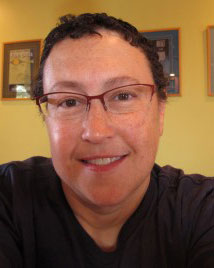 Tracy Fullerton, M.F.A., is a game designer, educator and author with twenty-five years of professional experience. She is currently Director of the joint USC Games Program, which is a collaboration between the School of Cinematic Arts and the Viterbi School of Engineering. She is also a Professor and Chair of the Interactive Media & Games Division of the USC School of Cinematic Arts. In December 2008, she was installed as the holder of the Electronic Arts Endowed Chair of Interactive Entertainment. Tracy is the author of Game Design Workshop: A Playcentric Approach to Designing Innovative Games. This design textbook is in use at game programs worldwide. Her research lab, the Game Innovation Lab, is a leading center for game design research. Recent credits include faculty adviser for the award-winning student games Cloud, and flOw; and game designer for The Night Journey, a unique game/art project with media artist Bill Viola. She is currently designing a game based on Henry David Thoreau's experiment in living at Walden Pond. Also, she is leading a team of designers to create a suite of college knowledge games collectively known as FutureBound Games. Tracy's work has received numerous industry honors including an Emmy nomination for interactive television, best Family/Board Game from the Academy of Interactive Arts & Sciences, most "sublime experience," the "Impact" and "Trailblazer" awards from the Indiecade Festival, ID Magazine's Interactive Design Review, Communication Arts Interactive Design Annual, several New Media Invision awards, iMix Best of Show, the Digital Coast Innovation Award, IBC's Nombre D'Or, Time Magazine's Best of the Web and the Hollywood Reporter's Women in Entertainment Power 100.
Tracy Fullerton, M.F.A., is a game designer, educator and author with twenty-five years of professional experience. She is currently Director of the joint USC Games Program, which is a collaboration between the School of Cinematic Arts and the Viterbi School of Engineering. She is also a Professor and Chair of the Interactive Media & Games Division of the USC School of Cinematic Arts. In December 2008, she was installed as the holder of the Electronic Arts Endowed Chair of Interactive Entertainment. Tracy is the author of Game Design Workshop: A Playcentric Approach to Designing Innovative Games. This design textbook is in use at game programs worldwide. Her research lab, the Game Innovation Lab, is a leading center for game design research. Recent credits include faculty adviser for the award-winning student games Cloud, and flOw; and game designer for The Night Journey, a unique game/art project with media artist Bill Viola. She is currently designing a game based on Henry David Thoreau's experiment in living at Walden Pond. Also, she is leading a team of designers to create a suite of college knowledge games collectively known as FutureBound Games. Tracy's work has received numerous industry honors including an Emmy nomination for interactive television, best Family/Board Game from the Academy of Interactive Arts & Sciences, most "sublime experience," the "Impact" and "Trailblazer" awards from the Indiecade Festival, ID Magazine's Interactive Design Review, Communication Arts Interactive Design Annual, several New Media Invision awards, iMix Best of Show, the Digital Coast Innovation Award, IBC's Nombre D'Or, Time Magazine's Best of the Web and the Hollywood Reporter's Women in Entertainment Power 100. Drew Davidson is a professor, producer and player of interactive media. His background spans academic, industry and professional worlds and he is interested in stories and transformational experiences across texts, comics, games and other media. He is the Director of the Entertainment Technology Center at Carnegie Mellon University and the Founding Editor of ETC Press and its Well Played series and journal. He also served as the interim Director for Randy Pausch's Alice Project. His professional activities are closely related to his research interests, as he has worked to help grow fields of study, creating forums and founding organizations to foster academic scholarship in new areas. He engages with academic and industry communities, leading grants, consulting for companies, institutions and organizations, and serving on advisory, editorial and review boards as well as judge and jury panels. He has supported the advancement of the academic study of games, along with the design and development of games for impact. He has also been involved in the growing academic study and creation of crossmedia communications and transmedia experiences. And he has worked on the academic study and production of creativity spaces located in public institutions like museums, libraries, science centers and schools. With his CMU colleagues, he is articulating best practices in creative development and how diversity improves innovation. He explores the art, design and science of making media that matters, working to expand our notions of what media are capable of doing, and what we are capable of doing with media. He has written and edited books, journals, articles and essays on narratives across media, serious games, analyzing gameplay, and cross-media communication.
Drew Davidson is a professor, producer and player of interactive media. His background spans academic, industry and professional worlds and he is interested in stories and transformational experiences across texts, comics, games and other media. He is the Director of the Entertainment Technology Center at Carnegie Mellon University and the Founding Editor of ETC Press and its Well Played series and journal. He also served as the interim Director for Randy Pausch's Alice Project. His professional activities are closely related to his research interests, as he has worked to help grow fields of study, creating forums and founding organizations to foster academic scholarship in new areas. He engages with academic and industry communities, leading grants, consulting for companies, institutions and organizations, and serving on advisory, editorial and review boards as well as judge and jury panels. He has supported the advancement of the academic study of games, along with the design and development of games for impact. He has also been involved in the growing academic study and creation of crossmedia communications and transmedia experiences. And he has worked on the academic study and production of creativity spaces located in public institutions like museums, libraries, science centers and schools. With his CMU colleagues, he is articulating best practices in creative development and how diversity improves innovation. He explores the art, design and science of making media that matters, working to expand our notions of what media are capable of doing, and what we are capable of doing with media. He has written and edited books, journals, articles and essays on narratives across media, serious games, analyzing gameplay, and cross-media communication. Eric Zimmerman is an award-winning game designer who has been inventing play on and off the computer for more than 25 years. Eric was the Co-Founder and Chief Design Officer of Gamelab, a game development company based in New York City. Gamelab's titles included the casual game blockbuster Diner Dash and Gamestar Mechanic, a site that lets kids create games, which was funded by the first major game-related grant from the MacArthur Foundation. Gamelab worked with partners including LEGO, HBO, VH-1, Nickelodeon, Yahoo!, Microsoft, Disney, Mattel, PlayFirst, PBS, Fisher-Price, Leapfrog, and many others. Eric is a founder of the Institute of Play, a nonprofit that looks at the intersection of games and learning that has opened a public school in New York City based on play as the model for learning. Eric has written and lectured extensively about game design and game culture. He is the co-author with Katie Salen of Rules of Play: Game Design Fundamentals (MIT Press, 2004). He is also the co-editor with Katie Salen of The Game Design Reader (MIT Press, 2006). With Nathalie Pozzi, principal of Nakworks, he has created large-scale game installations for the Museum of Modern Art, the Smithsonian American Art Museum, as well as venues in Berlin, Paris, Dublin, St, Petersberg, and Los Angeles. Recent projects include tabletop games The Metagame (with Local No. 12) and Quantum.
Eric Zimmerman is an award-winning game designer who has been inventing play on and off the computer for more than 25 years. Eric was the Co-Founder and Chief Design Officer of Gamelab, a game development company based in New York City. Gamelab's titles included the casual game blockbuster Diner Dash and Gamestar Mechanic, a site that lets kids create games, which was funded by the first major game-related grant from the MacArthur Foundation. Gamelab worked with partners including LEGO, HBO, VH-1, Nickelodeon, Yahoo!, Microsoft, Disney, Mattel, PlayFirst, PBS, Fisher-Price, Leapfrog, and many others. Eric is a founder of the Institute of Play, a nonprofit that looks at the intersection of games and learning that has opened a public school in New York City based on play as the model for learning. Eric has written and lectured extensively about game design and game culture. He is the co-author with Katie Salen of Rules of Play: Game Design Fundamentals (MIT Press, 2004). He is also the co-editor with Katie Salen of The Game Design Reader (MIT Press, 2006). With Nathalie Pozzi, principal of Nakworks, he has created large-scale game installations for the Museum of Modern Art, the Smithsonian American Art Museum, as well as venues in Berlin, Paris, Dublin, St, Petersberg, and Los Angeles. Recent projects include tabletop games The Metagame (with Local No. 12) and Quantum. Jarryd Huntley, a Civic Tech Fellow at Microsoft, plays important roles in Cleveland's game development scene as both an academic by teaching game development at Lorain County Community College, and as an independent game developer. His studio, Polytundra LLC, just released their debut title Art Club Challenge, which was featured in the 2017 Smithsonian American Art Museum Arcade. With talks at universities and conferences (including IndieCade and GDC), he brings a unique perspective by drawing on his experiences from software engineering and as a professional musician. In addition he recently finished co-authoring his first book, Game Programming for Artists, available now.
Jarryd Huntley, a Civic Tech Fellow at Microsoft, plays important roles in Cleveland's game development scene as both an academic by teaching game development at Lorain County Community College, and as an independent game developer. His studio, Polytundra LLC, just released their debut title Art Club Challenge, which was featured in the 2017 Smithsonian American Art Museum Arcade. With talks at universities and conferences (including IndieCade and GDC), he brings a unique perspective by drawing on his experiences from software engineering and as a professional musician. In addition he recently finished co-authoring his first book, Game Programming for Artists, available now. Hanna Brady is a freelance game writer. She works on mobile and indie games. Her first book, co-authored with Jarryd Huntley, is Game Programming for Artists. Her essay "Building A Queer Mythology" appeared in Queer Game Studies and her series of fantasy novellas, Arcana, has three installments currently available. In her spare time, she travels, plays the harp, and learns new board games.
Hanna Brady is a freelance game writer. She works on mobile and indie games. Her first book, co-authored with Jarryd Huntley, is Game Programming for Artists. Her essay "Building A Queer Mythology" appeared in Queer Game Studies and her series of fantasy novellas, Arcana, has three installments currently available. In her spare time, she travels, plays the harp, and learns new board games. Alec Holowka is a Canadian indie game developer, programmer, musician and game designer. He has worked on
Alec Holowka is a Canadian indie game developer, programmer, musician and game designer. He has worked on  John Sharp is a designer, art historian, curator and educator with thirty years of involvement in the creation and study of art and design. John's current design work focuses on cultural games, artgames and non-digital games. His current research addresses game aesthetics, the processes of creativity, and the intersections of aesthetics and ethics. He is an associate professor at Parsons The New School for Design. Along with Colleen Macklin, John co-directs PETLab (Prototyping, Education and Technology Lab), a research group focused on games and their design as a form of social discourse. John is also a member of the game design collective Local No. 12 along with Colleen Macklin (Associate Professor, Design & Technology, Parsons School of Design at The New School) and Eric Zimmerman (Arts Professor, New York University Game Center), a company focused on finding play in cultural practices. John's writing includes Works of Game: On the Aesthetics of Games and Art (MIT Press, 2015), Games, Design, and Play: A Detailed Approach to Iterative Game Design (co-author Colleen Macklin, Addison-Wesley, 2016), Fun, Taste, & Games: An Aesthetics for the Idle, Unproductive, and Otherwise Playful (co-author David Thomas, MIT Press, 2018), and Iterate: Ten Perspectives on Creativity and Failure (co-author Colleen Macklin, MIT Press, 2019). John was the curator of "Spacewar!: Videogames Blast Off" (2012) and "A Whole Different Ball Game: Playing Through 60 Years of Sports Video Games" (2018, co-curator Jason Eppink) at the Museum of the Moving Image and co-curator of "XYZ: Alternative Voices in Game Design" (2013) at the Museum of Design-Atlanta. John's Games include The Metagame (2015) and Losswords (2019).
John Sharp is a designer, art historian, curator and educator with thirty years of involvement in the creation and study of art and design. John's current design work focuses on cultural games, artgames and non-digital games. His current research addresses game aesthetics, the processes of creativity, and the intersections of aesthetics and ethics. He is an associate professor at Parsons The New School for Design. Along with Colleen Macklin, John co-directs PETLab (Prototyping, Education and Technology Lab), a research group focused on games and their design as a form of social discourse. John is also a member of the game design collective Local No. 12 along with Colleen Macklin (Associate Professor, Design & Technology, Parsons School of Design at The New School) and Eric Zimmerman (Arts Professor, New York University Game Center), a company focused on finding play in cultural practices. John's writing includes Works of Game: On the Aesthetics of Games and Art (MIT Press, 2015), Games, Design, and Play: A Detailed Approach to Iterative Game Design (co-author Colleen Macklin, Addison-Wesley, 2016), Fun, Taste, & Games: An Aesthetics for the Idle, Unproductive, and Otherwise Playful (co-author David Thomas, MIT Press, 2018), and Iterate: Ten Perspectives on Creativity and Failure (co-author Colleen Macklin, MIT Press, 2019). John was the curator of "Spacewar!: Videogames Blast Off" (2012) and "A Whole Different Ball Game: Playing Through 60 Years of Sports Video Games" (2018, co-curator Jason Eppink) at the Museum of the Moving Image and co-curator of "XYZ: Alternative Voices in Game Design" (2013) at the Museum of Design-Atlanta. John's Games include The Metagame (2015) and Losswords (2019). Lindsay Grace is an associate professor at American University and founding director of the American University Game Lab and Studio. He was the Fall 2017 Visiting Knight Chair at the University of Miami.In August, 2018 Lindsay will join the faculty of the University of Miami School of Communication as a Knight Chair. His work has received awards and recognition from the Games for Change Festival, the Digital Diversity Network, the Association of Computing Machinery's digital arts community, Black Enterprise and others. He has published more than 50 papers, articles and book chapters on games since 2009. His creative work has been selected for showcase internationally including New York, Paris, Sao Paolo, Singapore, Chicago, Vancouver, Istanbul, and others. He has given talks at the Game Developers Conference, SXSW, Games for Change Festival, the Online News Association, the Society for News Design, and many other industry events. Lindsay is vice president (2015-2016,2018) and board of directors for the Global Game Jam and Vice President of the Higher Education Video Game Alliance. Lindsay also served on the board for the Digital Games Research Association (DiGRA) between 2013-2015.
Lindsay Grace is an associate professor at American University and founding director of the American University Game Lab and Studio. He was the Fall 2017 Visiting Knight Chair at the University of Miami.In August, 2018 Lindsay will join the faculty of the University of Miami School of Communication as a Knight Chair. His work has received awards and recognition from the Games for Change Festival, the Digital Diversity Network, the Association of Computing Machinery's digital arts community, Black Enterprise and others. He has published more than 50 papers, articles and book chapters on games since 2009. His creative work has been selected for showcase internationally including New York, Paris, Sao Paolo, Singapore, Chicago, Vancouver, Istanbul, and others. He has given talks at the Game Developers Conference, SXSW, Games for Change Festival, the Online News Association, the Society for News Design, and many other industry events. Lindsay is vice president (2015-2016,2018) and board of directors for the Global Game Jam and Vice President of the Higher Education Video Game Alliance. Lindsay also served on the board for the Digital Games Research Association (DiGRA) between 2013-2015. Matthew Farber, Ed.D. is an assistant professor of Technology, Innovation, and Pedagogy at the University of Northern Colorado. He has been invited to the White House, to keynote for UNESCO, and he has been interviewed about games and learning by NPR, Fox News Radio, USA Today, and The Wall Street Journal. With Karen Schrier, Ed.D., he co-authored the UNESCO MGIEP working paper,
Matthew Farber, Ed.D. is an assistant professor of Technology, Innovation, and Pedagogy at the University of Northern Colorado. He has been invited to the White House, to keynote for UNESCO, and he has been interviewed about games and learning by NPR, Fox News Radio, USA Today, and The Wall Street Journal. With Karen Schrier, Ed.D., he co-authored the UNESCO MGIEP working paper,  Dr. Karen Schrier, Associate Professor, is the founding director of the Games & Emerging Media program at Marist College. From 2018-2019, she is also serving as a Belfer Fellow for the ADL's Center for Technology & Society, where she will be making anti-bias games and researching using games for perspective-taking, compassion, and bias reduction. Prior to Marist, she spent over a decade producing websites, apps, and games at organizations such as Scholastic, Nickelodeon, BrainPOP, and PBS/Channel 13. She is the editor of the book series, Learning, Education & Games, published by ETC Press (Carnegie Mellon), and co-editor of two books on games and ethics. She has written over 40 publications, including single-authored articles published in journals such as Educational Technology Research & Development and the Journal of Moral Education. With Matthew Farber, she co-authored the UNESCO MGIEP working paper, The Limits and Strengths of Using Digital Games as "Empathy Machines." Her latest book, Knowledge Games: How Playing Games Can Help Solve Problems, Create Insight, and Make Change, was published in 2016 by Johns Hopkins University Press. She is also working on a book for Oxford University Press on using games for civics and ethics education. Dr. Schrier holds a doctorate from Columbia University/Teachers College, master's degree from MIT, and a bachelor's degree from Amherst College.
Dr. Karen Schrier, Associate Professor, is the founding director of the Games & Emerging Media program at Marist College. From 2018-2019, she is also serving as a Belfer Fellow for the ADL's Center for Technology & Society, where she will be making anti-bias games and researching using games for perspective-taking, compassion, and bias reduction. Prior to Marist, she spent over a decade producing websites, apps, and games at organizations such as Scholastic, Nickelodeon, BrainPOP, and PBS/Channel 13. She is the editor of the book series, Learning, Education & Games, published by ETC Press (Carnegie Mellon), and co-editor of two books on games and ethics. She has written over 40 publications, including single-authored articles published in journals such as Educational Technology Research & Development and the Journal of Moral Education. With Matthew Farber, she co-authored the UNESCO MGIEP working paper, The Limits and Strengths of Using Digital Games as "Empathy Machines." Her latest book, Knowledge Games: How Playing Games Can Help Solve Problems, Create Insight, and Make Change, was published in 2016 by Johns Hopkins University Press. She is also working on a book for Oxford University Press on using games for civics and ethics education. Dr. Schrier holds a doctorate from Columbia University/Teachers College, master's degree from MIT, and a bachelor's degree from Amherst College. Katherine Isbister is a professor, games researcher, and author in the Department of Computational Media at the University of California, Santa Cruz. Katherine creates and studies digital games and other playful computer-supported experiences. Her focus is emotion and social connection--understanding the impact of design choices on these qualities, and getting better at building and evaluating technology that supports and enhances social and emotional experience. Her recent book,
Katherine Isbister is a professor, games researcher, and author in the Department of Computational Media at the University of California, Santa Cruz. Katherine creates and studies digital games and other playful computer-supported experiences. Her focus is emotion and social connection--understanding the impact of design choices on these qualities, and getting better at building and evaluating technology that supports and enhances social and emotional experience. Her recent book,  Diana Hughes is the Director of Adaptive Games at Age of Learning, Inc., a leading education technology company and creator of
Diana Hughes is the Director of Adaptive Games at Age of Learning, Inc., a leading education technology company and creator of  Allen Turner is a Professional Lecturer in Game Development and Interactive Media at DePaul University. Allen Turner has been involved in storytelling, game and play design, and education in one way or another for most of his adult life. In the non-profit world he has coordinated youth and adult programs focusing on literacy, storytelling, role-playing activities, and team dynamics as a mechanic for developing inference and problem solving skills. A student of acclaimed storytellers Shanta and Marcie Telander, Allen has also been active as a storyteller himself. He was a teller for the Chicago American Indian Center and Native American Studies College in Chicago (where he also provided storytelling workshops) in the early and mid 90s. He also provided regular cultural performances and presentations for the Chicago Public Schools and Chicago Public Library in addition to performances for the Illinois Teachers Conference, the Newberry Library, the Chicago Historical Society, and myriad other organizations and institutions. Allen's involvement with the video games industry began at Bungie Software where he started off as Tech Support and eventually grew to help out with the production polish of Myth II. He later went on to Day 1 Studios where he worked as a level designer for MechAssault on the X-Box. Most recently Allen was employed at Wideload Games/Disney Interactive Studios where he acted as a Lead Designer and Game Director. At Wideload he has worked on Stubbs the Zombie: Rebel Without a Pulse, and Hail to the Chimp, Guilty Party, and Avengers Initiative and Marvel XP. Allen is not only an active video game designer he also spends much of his time designing tabletop games as well. Most recently he published "Ehdrigohr: The Roleplaying Game" which is a dark fantasy horror game that draws inspiration from the folklore indigenous peoples around the world and while at the same time exploring the identity in culture and the processes of struggling against depression. He has hopes to bring his years of interacting, entertaining, and educating people to the table in designing games that are engaging and approachable for a wide variety of users.
Allen Turner is a Professional Lecturer in Game Development and Interactive Media at DePaul University. Allen Turner has been involved in storytelling, game and play design, and education in one way or another for most of his adult life. In the non-profit world he has coordinated youth and adult programs focusing on literacy, storytelling, role-playing activities, and team dynamics as a mechanic for developing inference and problem solving skills. A student of acclaimed storytellers Shanta and Marcie Telander, Allen has also been active as a storyteller himself. He was a teller for the Chicago American Indian Center and Native American Studies College in Chicago (where he also provided storytelling workshops) in the early and mid 90s. He also provided regular cultural performances and presentations for the Chicago Public Schools and Chicago Public Library in addition to performances for the Illinois Teachers Conference, the Newberry Library, the Chicago Historical Society, and myriad other organizations and institutions. Allen's involvement with the video games industry began at Bungie Software where he started off as Tech Support and eventually grew to help out with the production polish of Myth II. He later went on to Day 1 Studios where he worked as a level designer for MechAssault on the X-Box. Most recently Allen was employed at Wideload Games/Disney Interactive Studios where he acted as a Lead Designer and Game Director. At Wideload he has worked on Stubbs the Zombie: Rebel Without a Pulse, and Hail to the Chimp, Guilty Party, and Avengers Initiative and Marvel XP. Allen is not only an active video game designer he also spends much of his time designing tabletop games as well. Most recently he published "Ehdrigohr: The Roleplaying Game" which is a dark fantasy horror game that draws inspiration from the folklore indigenous peoples around the world and while at the same time exploring the identity in culture and the processes of struggling against depression. He has hopes to bring his years of interacting, entertaining, and educating people to the table in designing games that are engaging and approachable for a wide variety of users.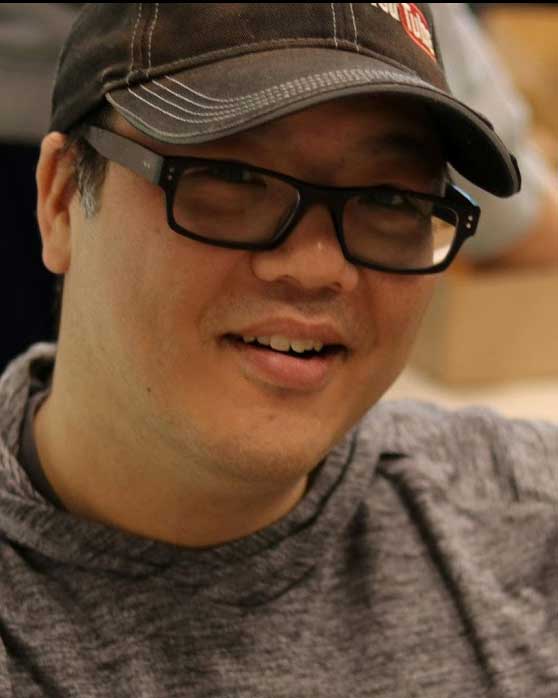 Mark Chen (PhD Education, University of Washington; BA Fine Art, Reed College) is an independent games scholar and part-time professor of interaction design, qualitative research, and games studies at the University of Washington Bothell. He runs
Mark Chen (PhD Education, University of Washington; BA Fine Art, Reed College) is an independent games scholar and part-time professor of interaction design, qualitative research, and games studies at the University of Washington Bothell. He runs  Bei Yang is a WDI technology studio executive for Walt Disney Imagineering. In his role, Bei oversees the functional as well as day-to-day operations of the business, design and construction software and technology for the organization. Bei advises and reviews technical implementation details on both WDI projects and processes involving technology with a focus on computer graphics, show control and overall systems integration. He collaborated with ILM and Lucas Film on an innovative attraction for the Star Wars-themed lands coming to Disneyland and Walt Disney World. Bei was the concept technical director for Goofy's Paint N' Play House at Disneyland Tokyo and the overall show control team lead for Shanghai Disneyland. Prior to joining Walt Disney Imagineering, Bei was a visual effects programmer for Schell Games, where his responsibilities included shading and lighting development, particle systems, 3D stereoscopic effects, and game prototyping for Toy Story Mania.
Bei Yang is a WDI technology studio executive for Walt Disney Imagineering. In his role, Bei oversees the functional as well as day-to-day operations of the business, design and construction software and technology for the organization. Bei advises and reviews technical implementation details on both WDI projects and processes involving technology with a focus on computer graphics, show control and overall systems integration. He collaborated with ILM and Lucas Film on an innovative attraction for the Star Wars-themed lands coming to Disneyland and Walt Disney World. Bei was the concept technical director for Goofy's Paint N' Play House at Disneyland Tokyo and the overall show control team lead for Shanghai Disneyland. Prior to joining Walt Disney Imagineering, Bei was a visual effects programmer for Schell Games, where his responsibilities included shading and lighting development, particle systems, 3D stereoscopic effects, and game prototyping for Toy Story Mania.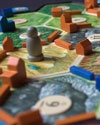 Build meaningful connections with your fellow conference goers while playing a digital or board game in the Meaningful Play Game Room.
Build meaningful connections with your fellow conference goers while playing a digital or board game in the Meaningful Play Game Room. Jared Riley, a 2006 graduate of MSU, has worked in the game industry for over a decade now on over forty game titles, thirty five award winning ones of which he designed himself and released through his company Hero Interactive garnering over 500 million plays. After Hero, Jared moved out west to San Francisco where he worked with first KIXEYE and then GREE on a number of chart topping free-to-play mobile titles that entertained massive audiences and each month brought in millions of dollars of revenue. Currently, Jared is an Engineering Manager at Twitch, working with the Extensions team to forever change how video games are shared with audiences.
Jared Riley, a 2006 graduate of MSU, has worked in the game industry for over a decade now on over forty game titles, thirty five award winning ones of which he designed himself and released through his company Hero Interactive garnering over 500 million plays. After Hero, Jared moved out west to San Francisco where he worked with first KIXEYE and then GREE on a number of chart topping free-to-play mobile titles that entertained massive audiences and each month brought in millions of dollars of revenue. Currently, Jared is an Engineering Manager at Twitch, working with the Extensions team to forever change how video games are shared with audiences.